Map Your Business Architecture to Define Your Strategy
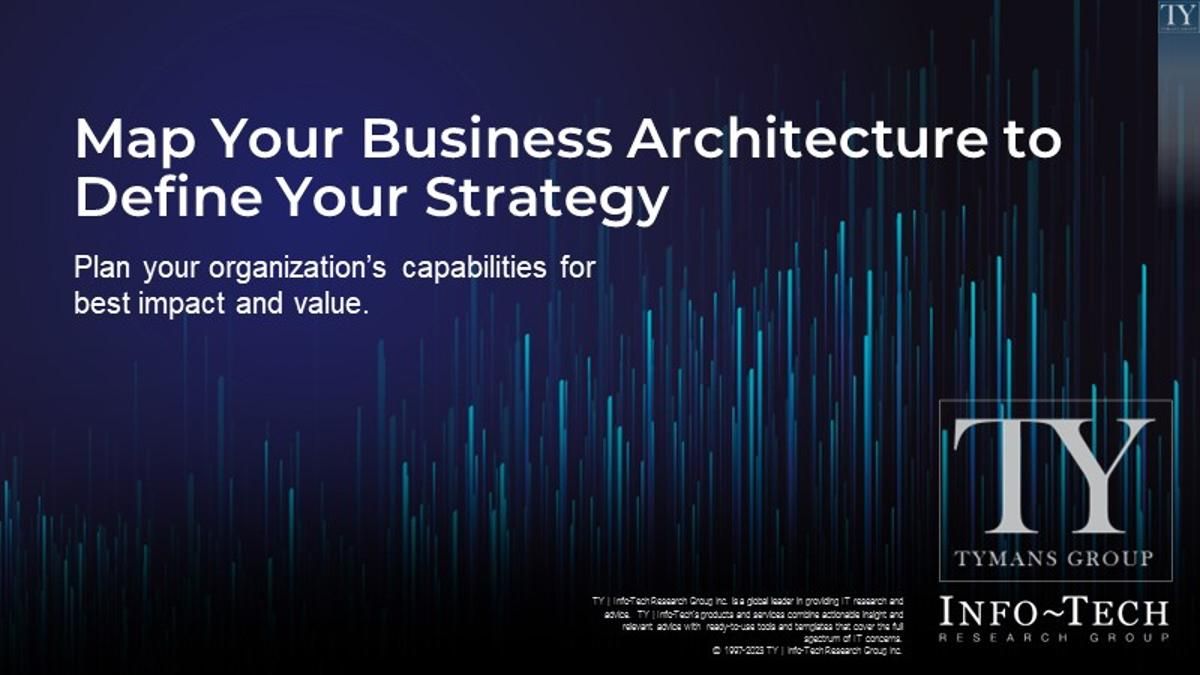
- Organizations need to innovate rapidly to respond to the changing forces in their industry, but their IT initiatives often fail to deliver meaningful outcomes.
- Planners face challenges in understanding the relationships between the important customer-focused innovations they’re trying to introduce and the resources (capabilities) that make them possible, including applications, human resources, information, and processes. For example, are we risking the success of a new service offering by underpinning it with a legacy or manual solution?
Our Advice
Critical Insight
Successful execution of business strategy requires planning that:
- Accurately reflects organizational capabilities.
- Is traceable so all levels can understand how decisions are made.
- Makes efficient use of organizational resources.
To accomplish this, the business architect must engage stakeholders, model the business, and drive planning with business architecture.
- Business architecture is often regarded as an IT function when its role and tools should be fixtures within the business planning and innovation practice.
- Any size of organization – from start-ups to global enterprises -- can benefit from using a common language and modeling rigor to identify the opportunities that will produce the greatest impact and value.
- You don’t need sophisticated modeling software to build an effective business architecture knowledgebase. In fact, the best format for engaging business stakeholders is intuitive visuals using business language.
Impact and Result
- Execute more quickly on innovation and transformation initiatives.
- More effectively target investments in resources and IT according to what goals and requirements are most important.
- Identify problematic areas (e.g. legacy applications, manual processes) that hinder the business strategy and create inefficiencies in our information technology operation.
Map Your Business Architecture to Define Your Strategy Research & Tools
Besides the small introduction, subscribers and consulting clients within this management domain have access to:
1. Map Your Business Architecture Deck – A step-by-step document that walks you through how to properly engage business and IT in applying a common language and process rigor to build key capabilities required to achieve innovation and growth goals.
Build a structured, repeatable framework for both IT and business stakeholders to appraise the activities that deliver value to consumers; and assess the readiness of their capabilities to enable them.
- Map Your Business Architecture to Define Your Strategy – Phases 1-3
2. Stakeholder Engagement Strategy Template – A best-of-breed template to help you build a clear, concise, and compelling strategy document for identifying and engaging stakeholders.
This template helps you ensure that your business architecture practice receives the resources, visibility, and support it needs to be successful, by helping you develop a strategy to engage the key stakeholders involved.
- Stakeholder Engagement Strategy Template
3. Value Stream Map Template – A template to walk through the value streams that are tied to your strategic goals.
Record the complete value stream and decompose it into stages. Add a description of the expected outcome of the value stream and metrics for each stage.
- Value Stream Map Template
4. Value Stream Capability Mapping Template – A template to define capabilities and align them to selected value streams.
Build a business capability model for the organization and map capabilities to the selected value stream.
- Value Stream – Capability Mapping Template
Workshop: Map Your Business Architecture to Define Your Strategy
Workshops offer an easy way to accelerate your project. If you are unable to do the project yourself, and a Guided Implementation isn't enough, we offer low-cost delivery of our project workshops. We take you through every phase of your project and ensure that you have a roadmap in place to complete your project successfully.
1 Discover the Business Context
The Purpose
Identify and consult stakeholders to discover the business goals and value proposition for the customer.
Key Benefits Achieved
Engage stakeholders and SMEs in describing the business and its priorities and culture.
Identify focus for the areas we will analyze and work on.
Activities
1.1 Select key stakeholders
1.2 Plan for engaging stakeholders
1.3 Gather business goals and priorities
Outputs
Stakeholder roles
Engagement plan
Business strategy, value proposition
2 Define Value Streams
The Purpose
Describe the main value-adding activities of the business from the consumer’s point of view, e.g. provide product or service.
Key Benefits Achieved
Shared understanding of why we build resources and do what we do.
Starting point for analyzing resources and investing in innovation.
Activities
2.1 Define or update value streams
2.2 Decompose selected value stream(s) into value stages and identify problematic areas and opportunities
Outputs
Value streams for the enterprise
Value stages breakdown for selected value stream(s)
3 Build Business Capability Map
The Purpose
Describe all the capabilities that make up an organization and enable the important customer-facing activities in the value streams.
Key Benefits Achieved
Basis for understanding what resources the organization has and their ability to support its growth and success.
Activities
3.1 Define and describe all business capabilities (Level 1)
3.2 Decompose and analyze capabilities for a selected priority value stream.
Outputs
Business Capability Map (Level 1)
Business Capabilities Level 2 for selected value stream
4 Develop a Roadmap
The Purpose
Use the Business Capability Map to identify key capabilities (e.g. cost advantage creator), and look more closely at what applications or information or business processes are doing to support or hinder that critical capability.
Key Benefits Achieved
Basis for developing a roadmap of IT initiatives, focused on key business capabilities and business priorities.
Activities
4.1 Identify key capabilities (cost advantage creators, competitive advantage creators)
4.2 Assess capabilities with the perspective of how well applications, business processes, or information support the capability and identify gaps
4.3 Apply analysis tool to rank initiatives
Outputs
Business Capability Map with key capabilities: cost advantage creators and competitive advantage creators
Assessment of applications or business processes or information for key capabilities
Roadmap of IT initiatives
Further reading
Map Your Business Architecture to Define Your Strategy
Plan your organization’s capabilities for best impact and value.
Info-Tech Research Group
Info-Tech is a provider of best-practice IT research advisory services that make every IT leader’s job easier.
| 35,000 members sharing best practices you can leverage | Millions spent developing tools and templates annually | Leverage direct access to over 100 analysts as an extension of your team | Use our massive database of benchmarks and vendor assessments | Get up to speed in a fraction of the time |
Analyst perspective
Know your organization’s capabilities to build a digital and customer-driven culture.
Business architecture provides a holistic and unified view of:
- All the organization’s activities that provide value to their clients (value streams).
- The resources that make them possible and effective (capabilities, i.e. its employees, software, processes, information).
- How they inter-relate, i.e. depend on and impact each other to help deliver value.
Without a business architecture it is difficult to see the connections between the business’s activities for the customer and the IT resources supporting them – to demonstrate that what we do in IT is customer-driven.
As a map of your business, the business architecture is an essential input to the digital strategy:
- Develop a plan to transform the business by investing in the most important capabilities.
- Ensure project initiatives are aligned with business goals as they evolve.
- Respond more quickly to customer requirements and to disruptions in the industry by streamlining operations and information sharing across the enterprise.

Crystal Singh
Research Director, Data and Analytics
Info-Tech Research Group

Andrea Malick
Research Director, Data and Analytics
Info-Tech Research Group
Executive summary
| Your Challenge | Common Obstacles | Info-Tech’s Approach |
|
Organizations need to innovate rapidly to respond to ever-changing forces and demands in their industry. But they often fail to deliver meaningful outcomes from their IT initiatives within a reasonable time. Successful companies are transforming, i.e. adopting fluid strategies that direct their resources to customer-driven initiatives and execute more quickly on those initiatives. In a responsive and digital organization, strategies, capabilities, information, people, and technology are all aligned, so work and investment are consistently allocated to deliver maximum value. |
You don’t have a complete reference map of your organization’s capabilities on which to base strategic decisions. You don’t know how to prioritize and identify the capabilities that are essential for achieving the organization’s customer-driven objectives. You don’t have a shared enterprise vision, where everyone understands how the organization delivers value and to whom. |
Begin important business decisions with a map of your organization – a business reference architecture. Model the business in the form of architectural blueprints. Engage your stakeholders. Recognize the opportunity for mapping work, and identify and engage the right stakeholders. Drive business architecture forward to promote real value to the organization. Assess your current projects to determine if you are investing in the right capabilities. Conduct business capability assessments to identify opportunities and prioritize projects. |
Info-Tech Insight
Business architecture is the set of strategic planning techniques that connects organization strategy to execution in a manner that is accurate and traceable and promotes the efficient use of organizational resources.
Blueprint activities summary
| Phase | Purpose | Activity | Outcome |
| 1. | Business context: Identify organization goals, industry drivers, and regulatory requirements in consultation with business stakeholders. |
Identify forces within and outside the organization to consider when planning the focus and timing of digital growth, through conducting interviews and surveys and reviewing existing strategies. | Business value canvas, business strategy on a page, customer journey |
| 2. | Customer activities (value stream): What is the customer doing? What is our reason for being as a company? What products and services are we trying to deliver? |
Define or update value streams, e.g. purchase product from supplier, customer order, and deliver product to customer. | Value streams enterprise-wide (there may be more than one set of value streams, e.g. a medical school and community clinic) |
| Prioritize value streams: Select key value streams for deeper analysis and focus. |
Assess value streams. | Priority value streams | |
| Value stages: Break down the selected value stream into its stages. |
Define stages for selected value streams. | Selected value stream stages | |
| 3. | Business capability map, level 1 enterprise: What resources and capabilities at a high level do we have to support the value streams? |
Define or update the business capabilities that align with and support the value streams. | Business capability map, enterprise-wide capabilities level 1 |
| Business capability map, level 2 for selected area: List resources and capabilities that we have at a more detailed level. |
Define or update business capabilities for selected value stream to level 2. | Business capability map, selected value stream, capability level 2 | |
| Heatmap Business Capability Map: Flag focus areas in supporting technology, applications, data and information. |
Info-Tech’s workshop methodology
| Day 1: Discover Business Context | Day 2: Define Value Streams | Day 3: Build Business Capability Map | Day 4: Roadmap Business Architecture | ||
|---|---|---|---|---|---|
| Phase Steps |
1.1 Collect corporate goals and strategies 1.2 Identify stakeholders |
2.1 Build or update value streams 2.2 Decompose selected value stream into value stages and analyze for opportunities |
3.1 Update business capabilities to level 1 for enterprise 3.2 For selected value streams, break down level 1 to level 2 |
3.3 Use business architecture to heatmap focus areas: technology, information, and processes 3.4 Build roadmap of future business architecture initiatives |
|
| Phase Outcomes |
|
|
|
|
Key concepts for this blueprint
| INDUSTRY VALUE CHAIN | DIGITAL TRANSFORMATION | BUSINESS ARCHITECTURE |
| A high-level analysis of how the industry creates value for the consumer as an overall end-to-end process. | The adoption of digital technologies to innovate and re-invent existing business, talent ,and operating models to drive growth, business value, and improved customer experience. | A holistic, multidimensional business view of capabilities, end-to-end value, and operating model in relation to the business strategy. |
| INDUSTRY VALUE STREAM | STRATEGIC OBJECTIVES | CAPABILITY ASSESSMENTS |
| A set of activities, tasks, and processes undertaken by a business or a business unit across the entire end-to-end business function to realize value. | A set of standard objectives that most industry players will feature in their corporate plans. | A heat-mapping effort to analyze the maturity and priority of each capability relative to the strategic priorities that they serve. |
Info-Tech’s approach
| 1 | Understand the business context and drivers Deepen your understanding of the organization’s priorities by gathering business strategies and goals. Talking to key stakeholders will allow you to get a holistic view of the business strategy and forces shaping the strategy, e.g. economy, workforce, and compliance. |
| 2 | Define value streams; understand the value you provide Work with senior leadership to understand your customers’ experience with you and the ways your industry provides value to them. Assess the value streams for areas to explore and focus on. |
| 3 | Customize the industry business architecture;
develop business capability map
Work with business architects and enterprise architects to customize Info-Tech’s business architecture for your industry as an enterprise-wide map of the organization and its capabilities. Extend the business capability map to more detail (Level 2) for the value stream stages you select to focus on. |
Business architecture is a planning function that connects strategy to execution
Business architecture provides a framework that connects business strategy and IT strategy to project execution through a set of models that provide clarity and actionable insights. How well do you know your business?
Business architecture is:
- Inter-disciplinary: Business architecture is a core planning activity that supports all important decisions in the organization, for example, organizational resources planning. It’s not just about IT.
- Foundational: The best way to answer the question, “Where do we start?” or “Where is our investment best directed?”, comes from knowing your organization, what its core functions and capabilities are (i.e. what’s important to us as an organization), and where there is work to do.
- Connecting: Digital transformation and modernization cannot work with siloes. Connecting siloes means first knowing the organization and its functions and recognizing where the siloes are not communicating.
Business architecture must be branded as a front-end planning function to be appropriately embedded in the organization’s planning process.
Brand business architecture as an early planning pre-requisite on the basis of maintaining clarity of communication and spreading an accurate awareness of how strategic decisions are being made.
As an organization moves from strategy toward execution, it is often unclear as to exactly how decisions pertaining to execution are being made, why priority is given to certain areas, and how the planning function operates.
The business architect’s primary role is to model this process and document it.
In doing so, the business architect creates a unified view as to how strategy connects to execution so it is clearly understood by all levels of the organization.
Business architecture is part of the enterprise architecture framework
| Business Architecture | ||
|---|---|---|
| Business strategy map | Business model canvas | Value streams |
| Business capability map | Business process flows | Service portfolio |
| Data Architecture | Application Architecture | Infrastructure Architecture |
| Conceptual data model | Application portfolio catalog | Technology standards catalog |
| Logical data model | Application capability map | Technology landscape |
| Physical data model | Application communication model | Environments location model |
| Data flow diagram | Interface catalog | Platform decomposition diagram |
| Data lifecycle diagram | Application use-case diagram | Network computing / hardware diagram |
| Security Architecture | ||
| Enterprise security model | Data security model | Application security model |
Business architecture is a set of shared and practical views of the enterprise
The key characteristic of the business architecture is that it represents real-world aspects of a business, along with how they interact.
Many different views of an organization are typically developed. Each view is a diagram that illustrates a way of understanding the enterprise by highlighting specific information about it:
- Business strategy view captures the tactical and strategic goals that drive an organization forward.
- Business capabilities view describes the primary business functions of an enterprise and the pieces of the organization that perform those functions.
- Value stream view defines the end-to-end set of activities that deliver value to external and internal stakeholders.
- Business knowledge view establishes the shared semantics (e.g. customer, order, and supplier) within an organization and relationships between those semantics (e.g. customer name, order date, supplier name) – an information map.
- Organizational view captures the relationships among roles, capabilities, and business units, the decomposition of those business units into subunits, and the internal or external management of those units.
Business architect connects all the pieces
The business owns the strategy and operating model; the business architect connects all the pieces together.
| R | Business Architect (Responsible) |
| A | Business Unit Leads (Accountable) |
| C | Subject Matter Experts (Consulted) – Business Lines, Operations, Data, Technology Systems & Infrastructure Leads |
| I | Business Operators (Informed) – Process, Data, Technology Systems & Infrastructure |
Choose a key business challenge to address with business architecture
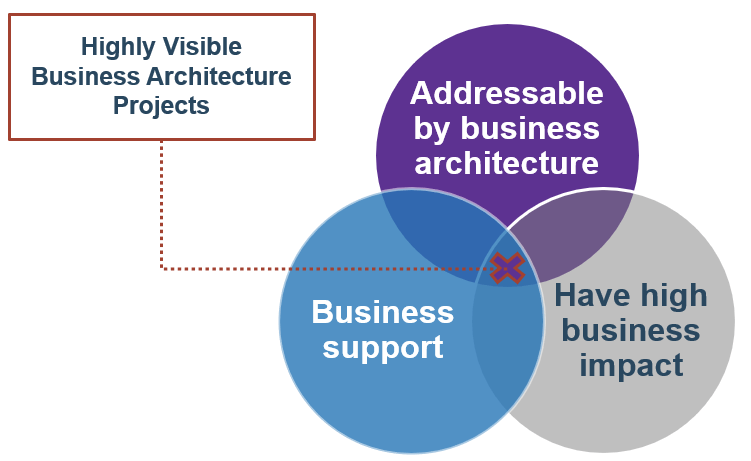
Picking the right project is critical to setting the tone for business architecture work in the organization.
Best practices for business architecture success
Consider these best practices to maintain a high level of engagement from key stakeholders throughout the process of establishing or applying business architecture.
Balance short-term cost savings with long-term benefits
Participate in project governance to facilitate compliance
Create a center of excellence to foster dialogue
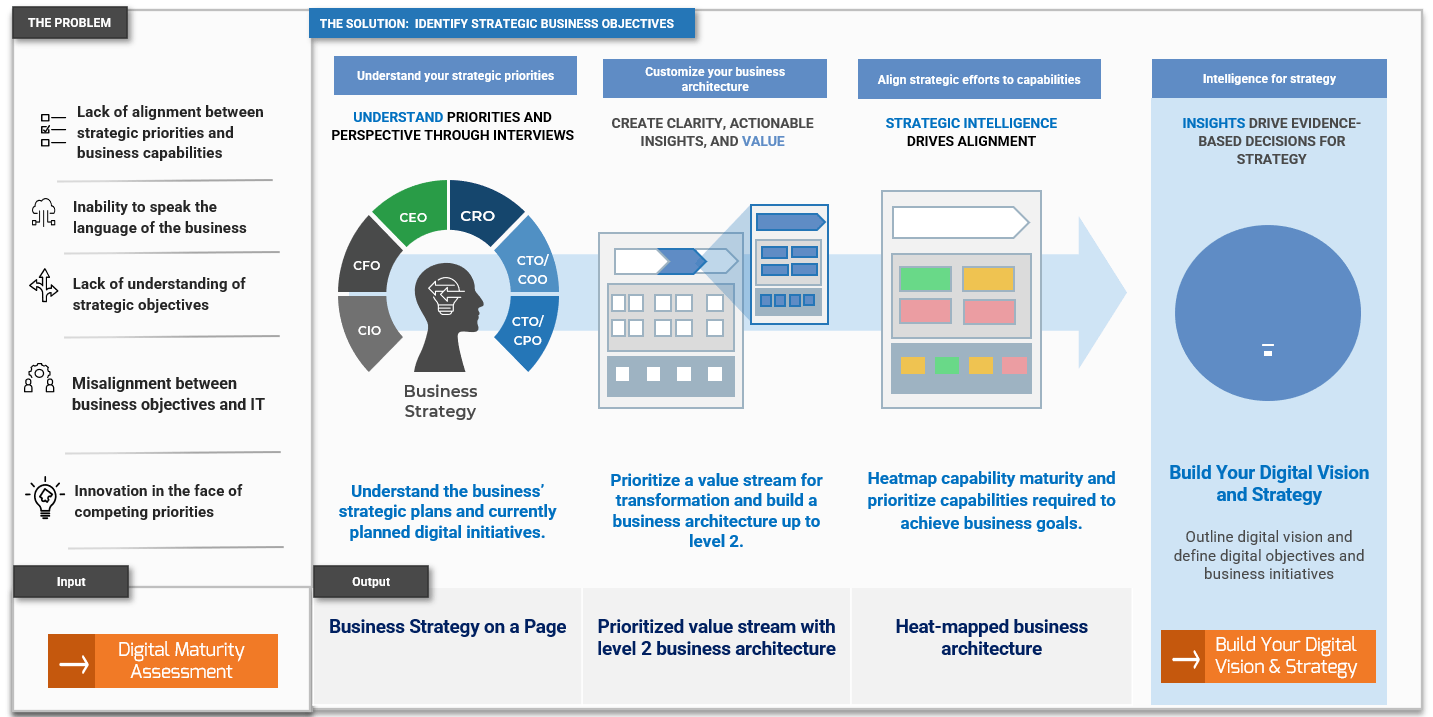
Value streams: Understand how you deliver value today
It is important to understand the different value-generating activities that deliver an outcome for and from your customers.
We do this by looking at value streams, which refer to the specific set of activities an industry player undertakes to create and capture value for and from the end consumer (and so the question to ask is, how do you make money as an organization?).
Our approach helps you to strengthen and transform those value streams that generate the most value for your organization.
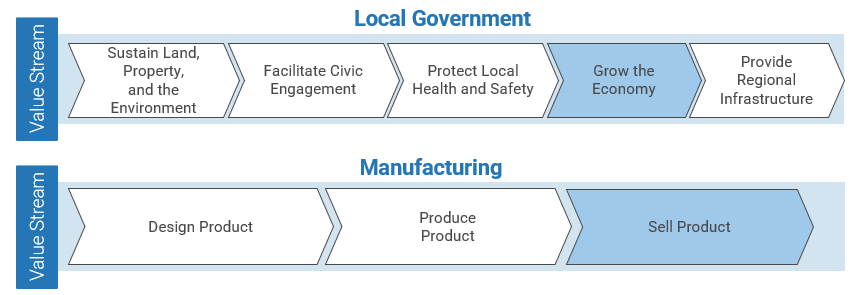
An organization can have more than one set of streams.
For example, an enterprise can provide both retail shopping and financial services, such as credit cards.
Define the organization’s value streams
- Value streams connect business goals to the organization’s value realization activities. They enable an organization to create and capture value in the market place by engaging in a set of interconnected activities. Those activities are dependent on the specific industry segment an organization operates within. Value streams can extend beyond the organization into the supporting ecosystem, whereas business processes are contained within and the organization has complete control over them.
- There are two types of value streams: core value streams and support value streams. Core value streams are mostly externally facing: they deliver value to either an external or internal customer and they tie to the customer perspective of the strategy map. Support value streams are internally facing and provide the foundational support for an organization to operate.
- An effective method for ensuring all value streams have been considered is to understand that there can be different end-value receivers. Info-Tech recommends identifying and organizing the value streams with customers and partners as end-value receivers.
Example: Value stream descriptions for the retail industry
| Value Streams | Create or Purchase the Product | Manage Inventory | Distribute Product | Sell Product, Make Product Available to Customers |
|---|---|---|---|---|
|
|
|
|
Value streams describe your core business

Value streams – the activities we do to provide value to customers – require business capabilities.
Value streams are broken down further into value stages, for example, the Sell Product value stream has value stages Evaluate Options, Place Order, and Make Payment.
Think of value streams as the core operations: the reason for your organization’s being. A professional consulting organization may have a legal team but it does not brand itself as a law firm. A core value stream is providing research products and services; a business capability that supports it is legal counsel.
Decompose the value stream into stages
The stages of a value stream are usually action-oriented statements or verbs that make up the individual steps involved throughout the scope of the value stream, e.g. Place Order or Make Payment.
Each value stream should have a trigger or starting point and an end result for a client or receiver.

There should be measurable value or benefits at each stage. These are key performance indicators (KPIs). Spot problem areas in the stream.
Value streams usually fall into one of these categories:
- Fulfillment of products and services
- Manufacturing
- Software products
- Supporting value streams (procurement of supplies, product planning)
Value streams need capabilities
- Value streams connect business goals to the organization’s value realization activities. They enable an organization to create and capture value in the market place by engaging in a set of interconnected activities.
- There are two types of value streams: core value streams and support value streams. Core value streams are mostly externally facing: they deliver value to either an external or internal customer and they tie to the customer perspective of the strategy map. Support value streams are internally facing and provide the foundational support for an organization to operate.
- There can be different end-value receivers. Info-Tech recommends identifying and organizing the value streams with customers and partners as end-value receivers.
Value streams need business capabilities
Business capabilities are built up to allow the business to perform the activities that bring value to customers. Map capabilities to the value-add activities in the value stream. Business capabilities lie at the top layer of the business architecture:
- They are the most stable reference for planning organizations.
- They make strategy more tangible.
- If properly defined, they can help overcome organizational silos.
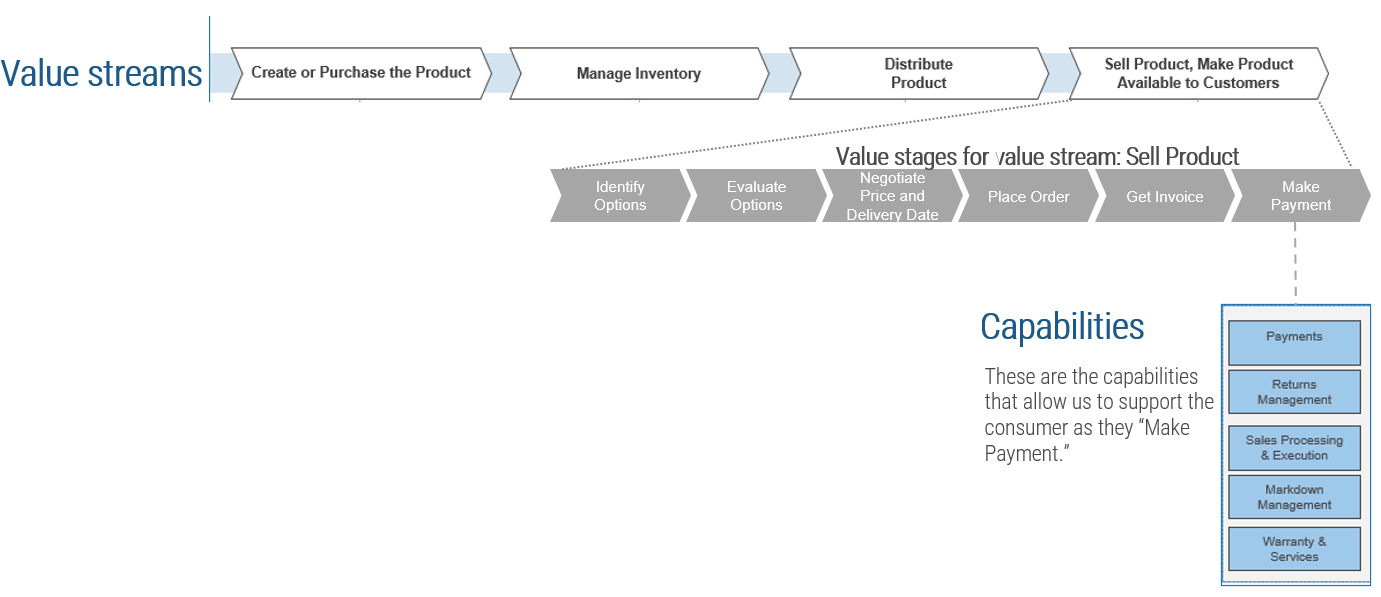
Example business capability map – Higher Education
A business capability map can be thought of as a visual representation of your organization’s business capabilities and represents a view of what your data program must support.
Validate your business capability map with the right stakeholders, including your executive team, business unit leaders, and/or other key stakeholders.
Example business capability map for: Higher Education
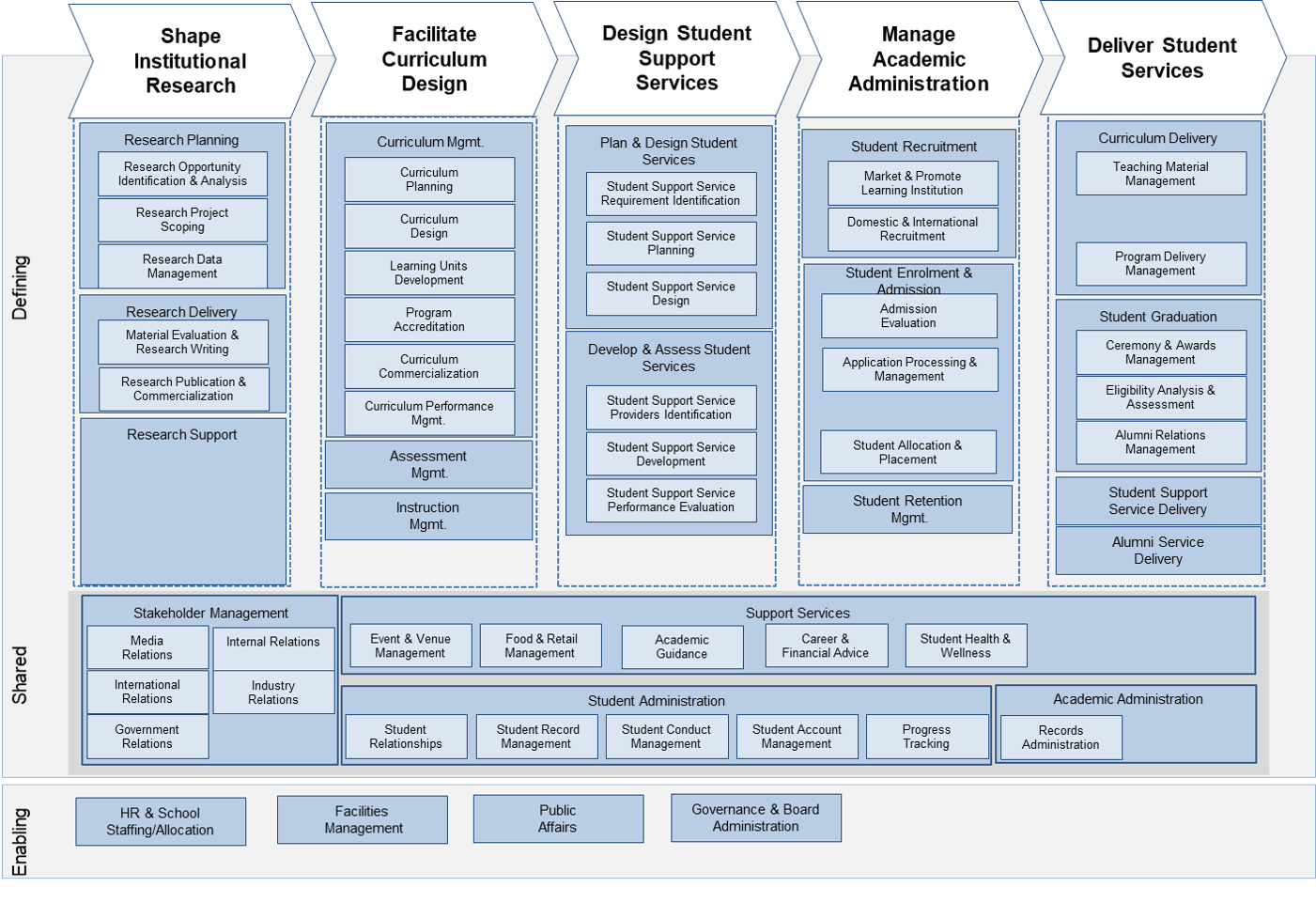
Example business capability map – Local Government
Validate your business capability map with the right stakeholders, including your executive team, business unit leaders, and/or other key stakeholders.
A business capability map can be thought of as a visual representation of your organization’s business capabilities and represents a view of what your data program must support.
Example business capability map for: Local Government
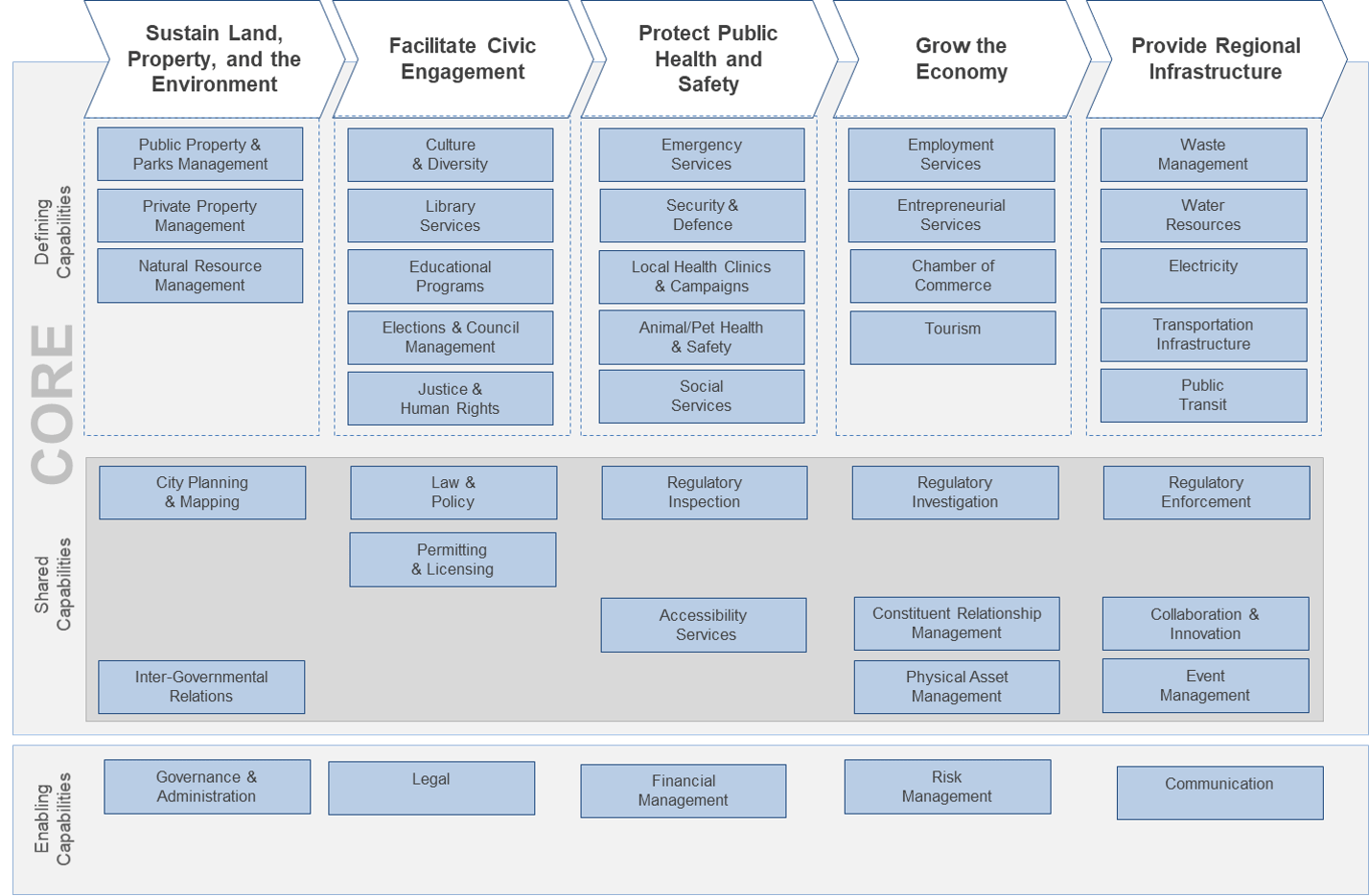
Value streams need business capabilities
Value streams – the activities we do to provide value to customers – require business capabilities. Value streams are broken down further into value stages.
Business capabilities are built up to allow the business to perform the activities that bring value to customers. Map capabilities to the activities in the value stage to spot opportunities and problems in delivering services and value.
Business processes fulfill capabilities. They are a step-by-step description of who is performing what to achieve a goal. Capabilities consist of networks of processes and the resources – people, technology, materials – to execute them.
Capability = Processes + Software, Infrastructure + People
Prioritize a value stream and identify its supporting capabilities
Prioritize your improvement objectives and business goals and identify a value stream to transform.
Align the business objectives of your organization to your value streams (the critical actions that take place within your organization to add value to a customer).
Prioritize a value stream to transform based on the number of priorities aligned to a value stream, and/or the business value (e.g. revenue, EBITDA earnings, competitive differentiation, or cost efficiency).
Decompose the selected value stream into value stages.
Align capabilities level 1 and 2 to value stages. One capability may support several value stages in the stream.
Build a business architecture for the prioritized value stream with a map of business capabilities up to level 2.
NOTE: We can’t map all capabilities all at once: business architecture is an ongoing practice; select key mapping initiatives each year based on business goals.
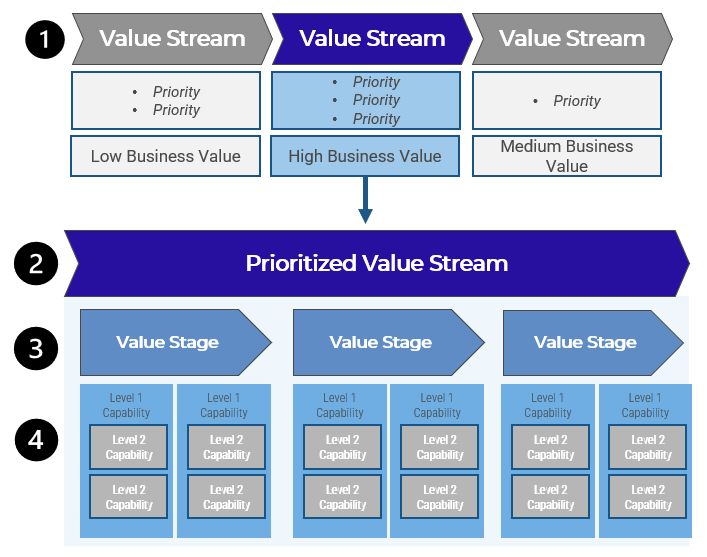
Map business capabilities to Level 2
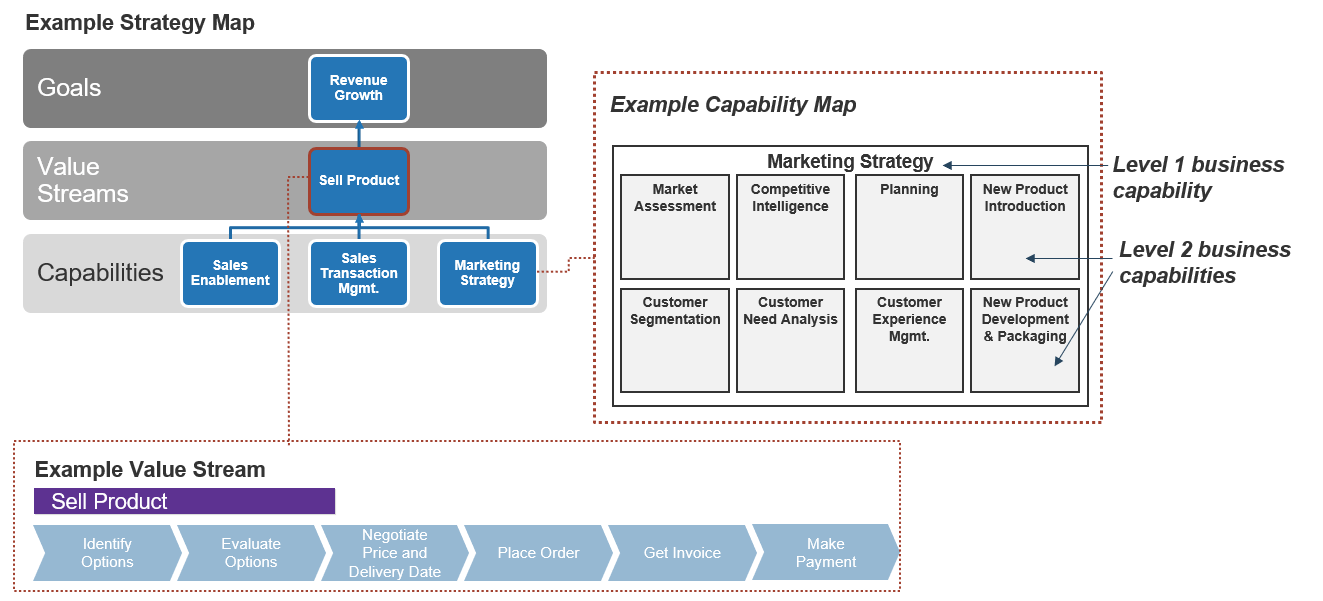
Map capabilities to value stage
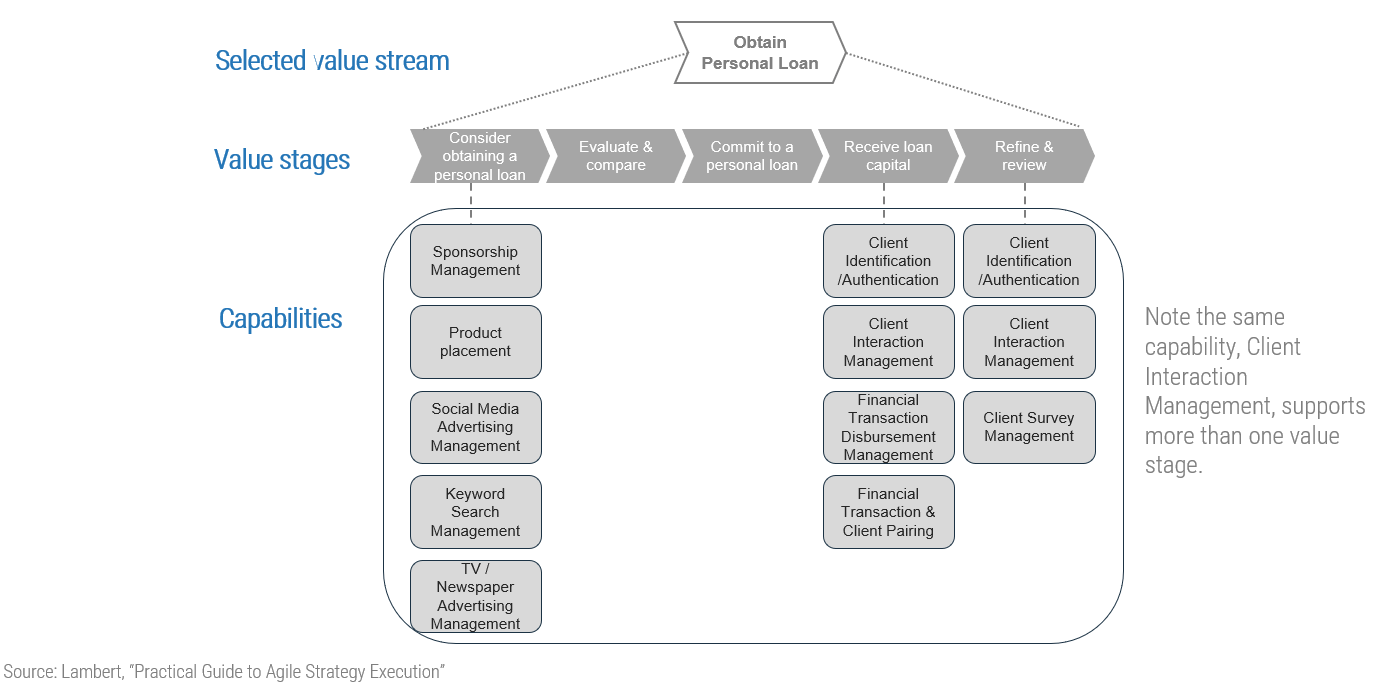
Business value realization
Business value defines the success criteria of an organization as manifested through organizational goals and outcomes, and it is interpreted from four perspectives:
- Profit generation: The revenue generated from a business capability with a product that is enabled with modern technologies.
- Cost reduction: The cost reduction when performing business capabilities with a product that is enabled with modern technologies.
- Service enablement: The productivity and efficiency gains of internal business operations from products and capabilities enhanced with modern technologies.
- Customer and market reach: The improved reach and insights of the business in existing or new markets.
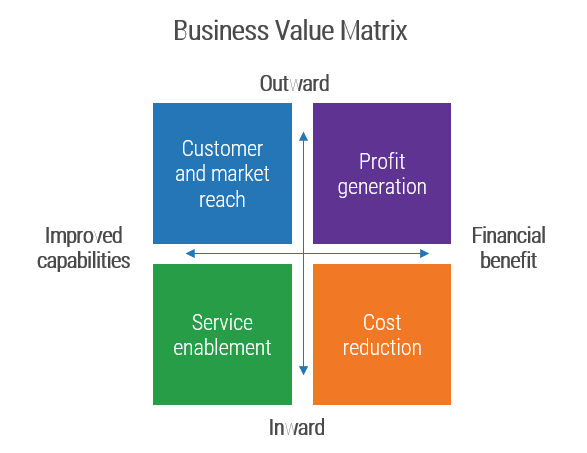
Value, goals, and outcomes cannot be achieved without business capabilities
Break down your business goals into strategic and achievable initiatives focused on specific value streams and business capabilities.
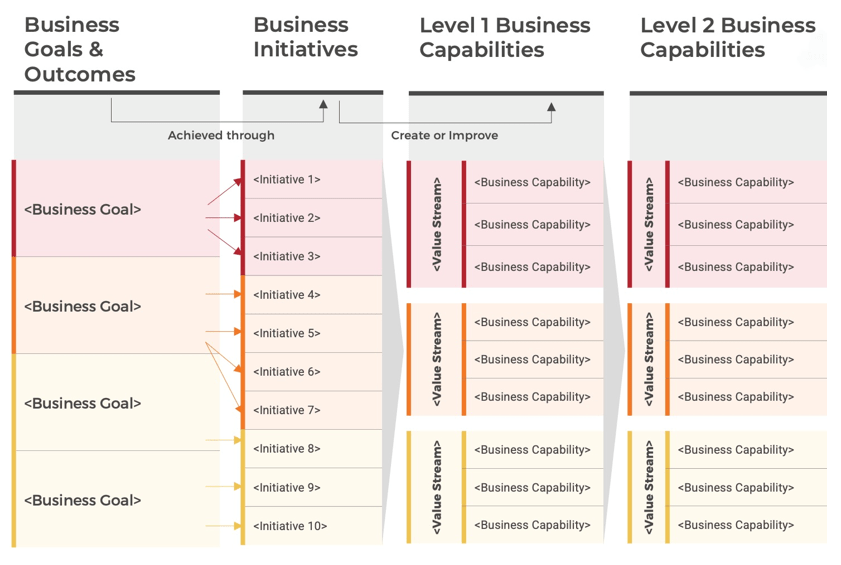
Accelerate the process with an industry business architecture
It’s never a good idea to start with a blank page.
The business capability map available from Info-Tech and with industry standard models can be used as an accelerator. Assemble the relevant stakeholders – business unit leads and product/service owners – and modify the business capability map to suit your organization’s context.
Acceleration path: Customize generic capability maps with the assistance of our industry analysts.
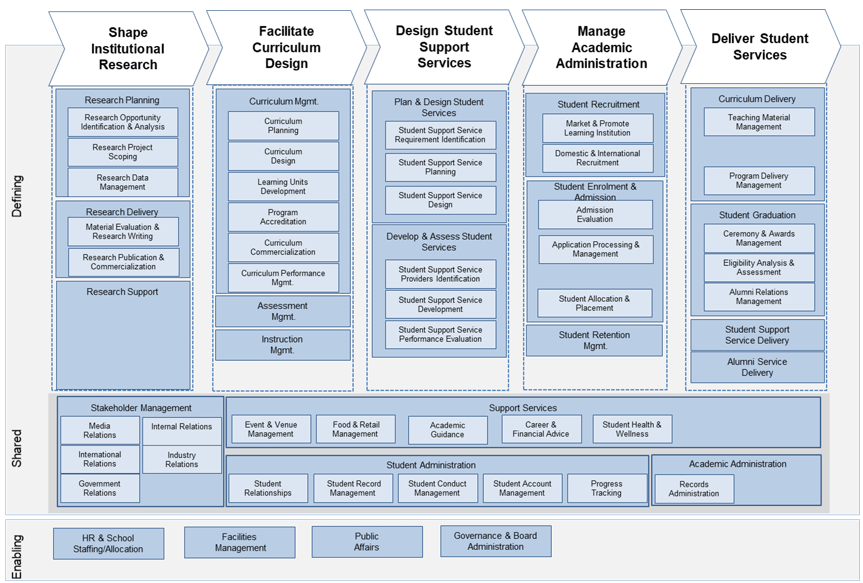
Identify goals and drivers
Consider organizational goals and industry forces when planning.
| Business context | Define value streams | Build business capability map |
|---|---|---|
| 1.1 Select key stakeholders 1.2 Collect and understand corporate goals |
2.1 Update or define value streams 2.2 Decompose and analyze selected value stream |
3.1 Build level 1 capability map 3.2 Build level 2 capability map 3.3 Heatmap capability map 3.4 Roadmap |
Use inputs from business goals and strategies to understand priorities.
It is not necessary to have a comprehensive business strategy document to start – with key stakeholders, the business architect should be able to gather a one-page business value canvas or customer journey.
Determine how the organization creates value
Begin the process by identifying and locating the business mission and vision statements.
What is business context?
“The business context encompasses an understanding of the factors impacting the business from various perspectives, including how decisions are made and what the business is ultimately trying to achieve. The business context is used by IT to identify key implications for the execution of its strategic initiatives.”
Source: Businesswire, 2018
Identify the key stakeholders who can help you promote the value of business architecture
First, as the CIO, you must engage executive stakeholders and secure their support.
Focus on key players who have high power and high interest in business architecture.
Engage the stakeholders who are impacted the most and have the power to impede the success of business architecture.
For example, if the CFO – who has the power to block funding – is disengaged, business architecture will be put at risk.
Use Info-Tech’s Stakeholder Power Map Template to help prioritize time spent with stakeholders.
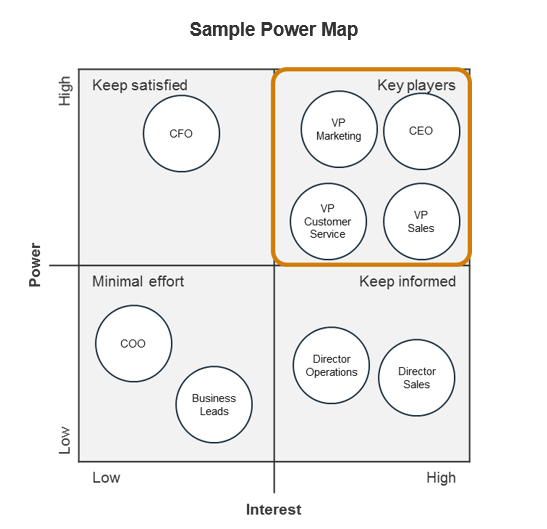
Identify the key stakeholders concerned with the business architecture project
A business architecture project may involve the following stakeholders:
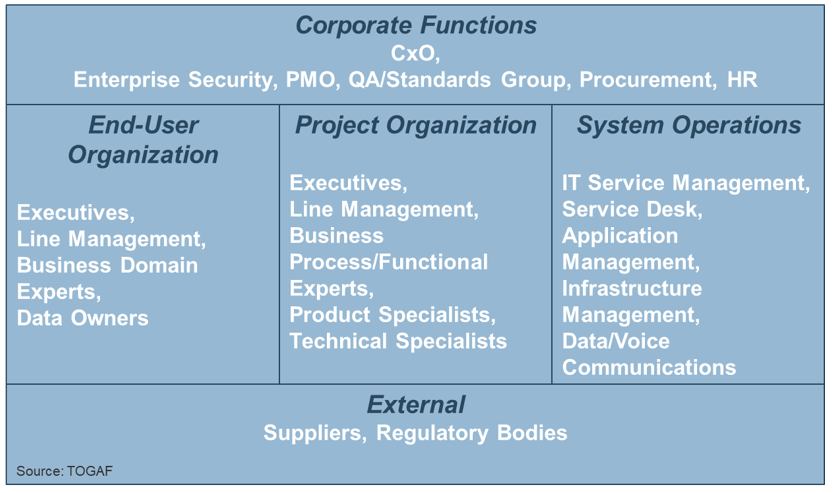
You must identify who the stakeholders are for your business architecture work.
Think about:
- Who are the decision makers and key influencers?
- Who will impact the business architecture work? Who will the work impact?
- Who has vested interest in the success or failure of the practice?
- Who has the skills and competencies necessary to help us be successful?
Avoid these common mistakes:
- Don’t focus on the organizational structure and hierarchy. Often stakeholder groups don’t fit the traditional structure.
- Don’t ignore subject-matter experts on either the business or IT side. You will need to consider both.
1.1 Identify and assemble key stakeholders
1-3 hours
Build an accurate depiction of the business.
- It is important to make sure the right stakeholders participate in this exercise. The exercise of identifying capabilities for an organization is very introspective and requires deep analysis.
- Consider:
- Who are the decision makers and key influencers?
- Who will impact the business capability work? Who has a vested interest in the success or failure of the outcome?
- Who has the skills and competencies necessary to help you be successful?
- Avoid:
- Don’t focus on the organizational structure and hierarchy. Often stakeholder groups don’t fit the traditional structure.
- Don’t ignore subject matter experts on either the business or IT side. You will need to consider both.
| Input | Output |
|---|---|
|
|
| Materials | Participants |
|
|
Conduct interviews with the business to gather intelligence for strategy
Talking to key stakeholders will allow you to get a holistic view of the business strategy.

Build a strategy on a page through executive interviews and document reviews
Understanding the business mandate and priorities ensures alignment across the enterprise.
A business strategy must articulate the long-term destination the business is moving into. This illustration shapes all the strategies and activities in every other part of the business, including what IT capabilities and resources are required to support business goals. Ultimately, the benefits of a well-defined business strategy increase as the organization scales and as business units or functions are better equipped to align the strategic planning process in a manner that reflects the complexity of the organization.
Using the Business Strategy on a Page canvas, consider the questions in each bucket to elicit the overall strategic context of the organization and uncover the right information to build your digital strategy. Interview key executives including your CEO, CIO, CMO, COO, CFO, and CRO, and review documents from your board or overall organizational strategy to uncover insights.
Info-Tech Insight
A well-articulated and clear business strategy helps different functional and business units work together and ensures that individual decisions support the overall direction of the business.
Focus on business value and establish a common goal
Business architecture is a strategic planning function and the focus must be on delivering business value.
Examples business objectives:
- Digitally transform the business, redefining its customer interactions.
- Identify the root cause for escalating customer complaints and eroding satisfaction.
- Identify reuse opportunities to increase operational efficiency.
- Identify capabilities to efficiently leverage suppliers to handle demand fluctuations.
Info-Tech Insight
CIOs are ideally positioned to be the sponsors of business architecture given that their current top priorities are digital transformation, innovation catalyzation, and business alignment.
1.2 Collect and understand business objectives
1-3 hours
Having a clear understanding of the business is crucial to executing on the strategic IT initiatives.
- Discover the strategic CIO initiatives your organization will pursue:
- Schedule interviews.
- Use the CIO Business Vision diagnostic or Business Context Discovery Tool.
| Input | Output |
|---|---|
|
|
| Materials | Participants |
|
|
CEO
|
Vision Where do you want to go? Mission/Mandate What do you do? |
Value Streams Why are you in business? What do you do? |
Key Products & Services What are your top three to five products and services? |
Key Customer Segments Who are you trying to serve or target? |
|
Value Proposition What is the value you deliver to your customers? Future Value Proposition What is your value proposition in three to five years’ time? |
Digital Experience Aspirations How can you create a more effective value stream? |
Business Resilience Aspirations How can you reduce business risks? |
Sustainability (or ESG) Aspirations How can you deliver ESG and sustainability goals? |
Interview the following executives for each business goal area.
|
CEO |
Core Business Goals What are the core business goals to meet business objectives? |
Top Priorities & Initiatives What are the top initiatives and priorities over the planning horizon? |
Performance Insights/Metrics What do we need to achieve? |
|
CMO |
Shared Business Goals What are the shared (operational) business goals to meet business objectives? |
Top Priorities & Initiatives What are the top initiatives and priorities over the planning horizon? |
Performance Insights/Metrics What do we need to achieve? |
|
CFO |
Enabling Business Goals What are the enabling (supporting/enterprise) business goals to meet business objectives? |
Top Priorities & Initiatives What are the top initiatives and priorities over the planning horizon? |
Performance Insights/Metrics What do we need to achieve? |
Craft a strategy to increase stakeholder support and participation
The BA practice’s supporters are potential champions who will help you market the value of BA; engage with them first to create positive momentum. Map out the concerns of each group of stakeholders so you can develop marketing tactics and communications vehicles to address them.
Example Communication Strategy
| Stakeholder Concerns | Tactics to Address Concerns | Communication Vehicles | Frequency | |
|---|---|---|---|---|
| Supporters (High Priority) |
|
|
|
Bi-Monthly |
| Indifferent (Medium Priority) |
|
|
|
Quarterly |
| Resistors (Medium Priority) |
|
|
|
Tailored to individual groups |
1.3 Craft a strategy to increase stakeholder support and participation
1-2 hours
Now that you have organized and categorized your stakeholders based on their power, influence, interest, and knowledge of business architecture, it is time to brainstorm how you are going to gain their support and participation.
Think about the following:
- What are your stakeholders’ concerns?
- How can you address them?
- How will you deliver the message?
- How often will you deliver the message?
Avoid these common mistakes:
- Your communication strategy development should be an iterative process. Do not assume to know the absolute best way to get through to every resistor right away. Instead, engage with your supporters for their input on how to communicate to resistors and repeat the process for indifferent stakeholders as well.
| Input | Output |
|---|---|
|
|
|
| Materials | Participants |
|
|
Download the Stakeholder Engagement Strategy Template for this project.
Engaging the right stakeholders
CASE STUDY
IndustryFinancial - Banking
Source
Anonymous
| Situation | Complication | Result |
|---|---|---|
|
To achieve success with the business architecture initiative, the bank’s CIO needed to put together a plan to engage the right stakeholders in the process. Without the right stakeholders, the initiative would suffer from inadequate information and thus would run the risk of delivering an ineffective solution. |
The bank’s culture was resistant to change and each business unit had its own understanding of the business strategy. This was a big part of the problem that led to decreasing customer satisfaction. The CIO needed a unified vision for the business architecture practice involving people, process, and technology that all stakeholders could support. |
Starting with enlisting executive support in the form of a business sponsor, the CIO identified the rest of the key stakeholders, in this case, the business unit heads, who were necessary to engage for the initiative. Once identified, the CIO promoted the benefits of business architecture to each of the business unit heads while taking stock of their individual needs. |
1.4 Develop a plan to engage key stakeholders
1 hour
Using your stakeholder power map as a starting point, focus on the three most important quadrants: those that contain stakeholders you must keep informed, those to keep satisfied, and the key players.
Plot the stakeholders from those quadrants on a stakeholder engagement map.
Think about the following:
- Who are your resistors? These individuals will actively detract from project’s success if you don’t address their concerns.
- Who is indifferent? These individuals need to be educated more on the benefits of business architecture to have an opinion either way.
- Who are your supporters? These individuals will support you and spread your message if you equip them to do so.
Avoid these common mistakes:
- Do not jump to addressing resistor concerns first. Instead, equip your supporters with the info they need to help your cause and gain positive momentum before approaching resistors.
| Input | Output |
|---|---|
|
|
| Materials | Participants |
|
|
Download the Stakeholder Engagement Strategy Template for this project.
1.5 Craft a strategy to increase stakeholder support and participation
1-2 hours
Now that you have organized and categorized your stakeholders based on their power, influence, interest, and knowledge of business architecture, it is time to brainstorm how you are going to gain their support and participation.
Think about the following:
- What are your stakeholders’ concerns?
- How can you address them?
- How will you deliver the message?
- How often will you deliver the message?
Avoid these common mistakes:
- Your communication strategy development should be an iterative process. Do not assume to know the absolute best way to get through to every resistor right away. Instead, engage with your supporters for their input on how to communicate to resistors and repeat the process for indifferent stakeholders as well.
| Input | Output |
|---|---|
|
|
| Materials | Participants |
|
|
Download the Stakeholder Engagement Strategy Template for this project.
Define value streams
Identify the core activities your organization does to provide value to your customers.
| Business context | Define value streams | Build business capability map |
|---|---|---|
|
1.1 Select key stakeholders |
2.1 Update or define value streams |
3.1 Build Level 1 capability map |
This phase will walk you through the following activities:
- Note: It is recommended that you gather and leverage relevant industry standard business architecture models you may have available to you. Example: Info-Tech Industry Business Architecture, BIZBOK, APQC.
- Defining or updating the organization’s value streams.
- Selecting priority value streams for deeper analysis.
This phase involves the following participants:
- Business Architect, Enterprise Architect
- Relevant Business Stakeholder(s): Business Unit Leads, Departmental Executives, Senior Mangers, Business Analysts
Define the organization’s value streams
- Value streams connect business goals to the organization’s value realization activities. They enable an organization to create and capture value in the marketplace by engaging in a set of interconnected activities. Those activities are dependent on the specific industry segment an organization operates within. Value streams can extend beyond the organization into the supporting ecosystem, whereas business processes are contained within and the organization has complete control over them.
- There are two types of value streams: core value streams and support value streams. Core value streams are mostly externally facing: they deliver value to either an external or internal customer and they tie to the customer perspective of the strategy map. Support value streams are internally facing and provide the foundational support for an organization to operate.
- An effective method for ensuring all value streams have been considered is to understand that there can be different end-value receivers. Info-Tech recommends identifying and organizing the value streams with customers and partners as end-value receivers.
Connect business goals to value streams
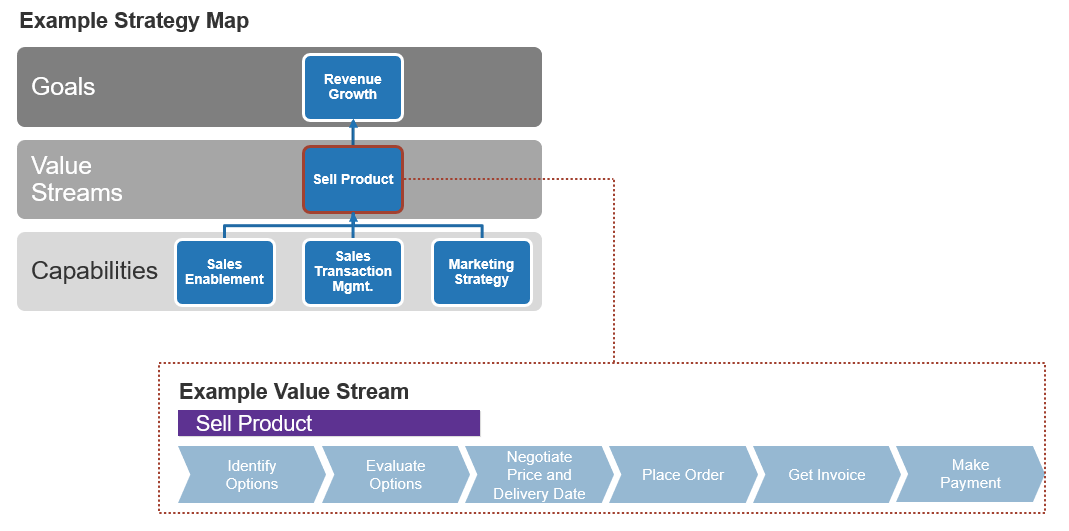
Identifying value streams
Value streams connect business goals to organization’s value realization activities. They enable an organization to create and capture value in the market place by engaging in a set of interconnected activities.
There are several key questions to ask when endeavoring to identify value streams.
| Key Questions |
|---|
|
Example: Value stream descriptions for the retail industry
| Value Streams | Create or Purchase Product | Manage Inventory | Distribute Product | Sell Product |
|
|
|
|
Value streams describe your core business
Value streams – the activities we do to provide value to customers – require business capabilities.
Value streams are broken down further into value stages, for example, Sell Product value stream has value stages Evaluate Options, Place Order, and Make Payment.
Think of value streams as the core operations, the reason for our organization’s being. A professional consulting organization may have a legal team but it does not brand itself as a law firm. A core value stream is providing research products and services – a business capability that supports it is legal counsel.
2.1 Define value streams
1-3 hours
Unify the organization’s perspective on how it creates value.
- Write a short description of the value stream that includes a statement about the value provided and a clear start and end for the value stream. Validate the accuracy of the descriptions with your key stakeholders.
- Consider:
- How does the organization deliver those benefits?
- How does the customer receive the benefits?
- What is the scope of your value stream? What will trigger the stream to start and what will the final value be?
- Avoid: Don’t start with a blank page. Use Info-Tech’s business architecture models for sample value streams.
| Input | Output |
|---|---|
|
|
| Materials | Participants |
|
|
See your Info-Tech Account Representative for access to the Reference Architecture Template
Decompose the value stream into stages
The stages of a value stream are usually action-oriented statements or verbs that make up the individual steps involved throughout the scope of the value stream, e.g. Place Order or Make Payment.
Each value stream should have a trigger or starting point and an end result for a client or receiver.

There should be measurable value or benefits at each stage.
These are key performance indicators (KPIs).
Spot problem areas in the stream.
Value streams usually fall into one of these categories:
- Fulfillment of products and services
- Manufacturing
- Software products
- Supporting value streams (procurement of supplies, product planning)
Value stream and value stages examples
Customer Acquisitions
Identify Prospects > Contact Prospects > Verify Interests
Sell Product
Identify Options > Evaluate Options > Negotiate Price and Delivery Date > Place Order > Get Invoice > Make Payment
Product Delivery
Confirm Order > Plan Load > Receive Warehouse > Fill Order > Ship Order > Deliver Order > Invoice Customer
Product Financing
Initiate Loan Application > Decide on Application > Submit Documents > Review & Satisfy T&C > Finalize Documents > Conduct Funding > Conduct Funding Audits
Product Release
Ideate > Design > Build > Release
Sell Product is a value stream, made up of value stages Identify options, Evaluate options, and so on.
2.2 Decompose selected value streams
1-3 hours
Once we have a good understanding of our value streams, we need to decide which ones to focus on for deeper analysis and modeling, e.g. extend the business architecture to more detailed level 2 capabilities.
Organization has goals and delivers products or services.
- Identify which value propositions are most important, e.g. be more productive or manage money more simply.
- Identify the value stream(s) that create the value proposition.
- Break the selected value stream into value stages.
- Analyze value stages for opportunities.
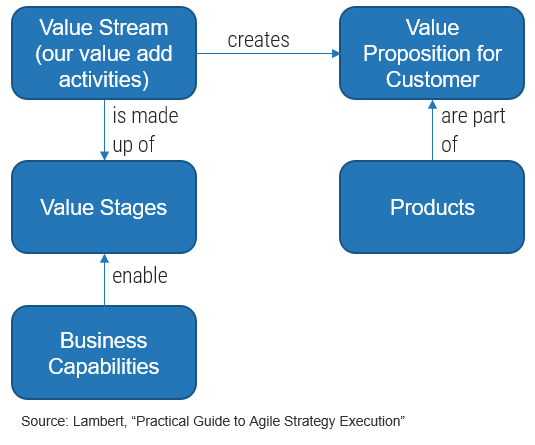
| Input | Output |
|---|---|
|
|
| Materials | Participants |
|
|
Build your value stream one layer at a time to ensure clarity and comprehensiveness
The first step of creating a value stream is defining it.
- In this step, you create the parameters around the value stream and document them in a list format.
- This allows you to know where each value stream starts and ends and the unique value it provides.
The second step is the value stream mapping.
- The majority of the mapping is done here where you break down your value stream into each of its component stages.
- Analysis of these stages allows for a deeper understanding of the value stream.
- The mapping layer connects the value stream to organizational capabilities.
Define the value streams that are tied to your strategic goals and document them in a list
Title
- Create a title for your value stream that indicates the value it achieves.
- Ensure your title is clear and will be understood the same way across the organization.
- The common naming convention for value streams is to use nouns, e.g. product purchase.
Scope
- Determine the scope of your value stream by defining the trigger to start the value stream and final value delivered to end the value stream.
- Be precise with your trigger to ensure you do not mistakenly include actions that would not trigger your value stream.
- A useful tip is creating a decision tree and outlining the path that results in your trigger.
Objectives
- Determine the objectives of the value stream by highlighting the outcome it delivers.
- Identify the desired outcomes of the value stream from the perspective of your organization.
Example Value Streams List
| Title | Scope | Objectives |
| Sell Product | From option identification to payment | Revenue Growth |
| … | … | … |
| … | … | … |
Create a value stream map
| A Decompose the Value Stream Into Stages | B Add the Customer Perspective |
|
|
| C Add the Expected Outcome | D Define the Entry and Exit Criteria |
|
|
| E Outline the Metrics | F Assess the Stages |
|
|
Decompose the value stream into its value stages
The first step in creating a value stream map is breaking it up into its component stages.
The stages of a value stream are usually action-oriented statements or verbs that make up the individual steps involved throughout the scope of the value stream.
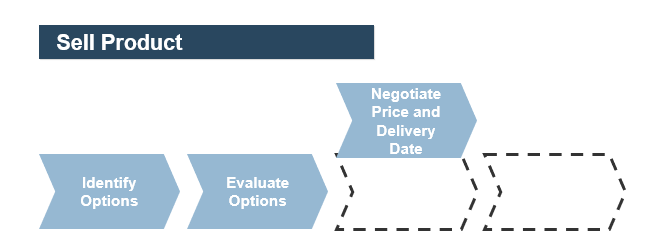
The Benefit
Segmenting your value stream into individual stages will give you a better understanding of the steps involved in creating value.
Connect the stages of the value stream to a specific customer perspective
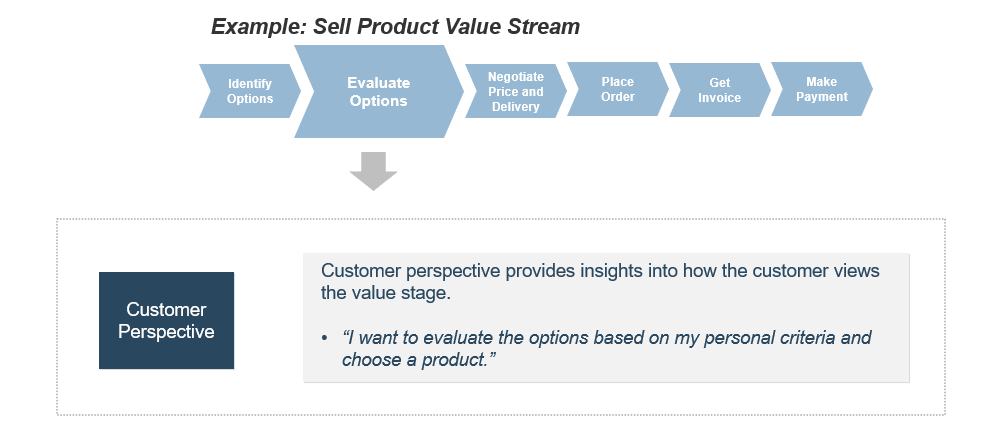
The Benefit
Adding the customer’s perspective will inform you of their priorities at each stage of the value stream.
Connect the stages of the value stream to a desired outcome
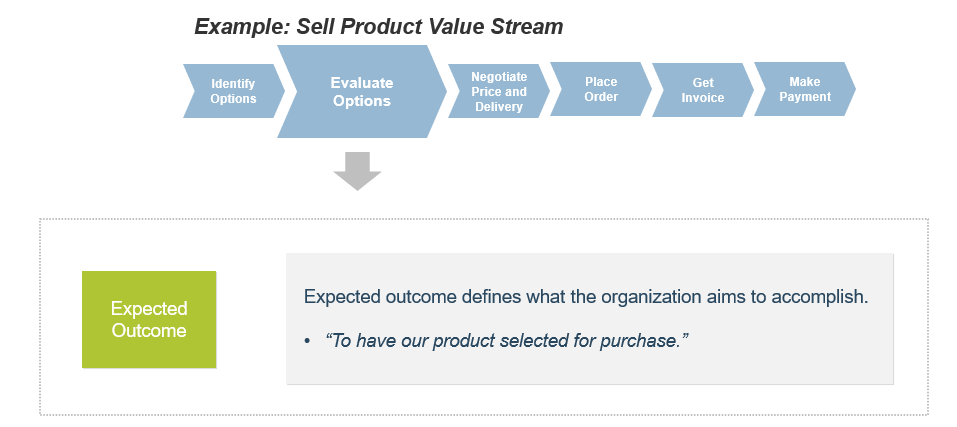
The Benefit
Understanding the organization’s desired outcome at each stage of the value stream will help set objectives and establish metrics.
Define the entry and exit criteria of each stage
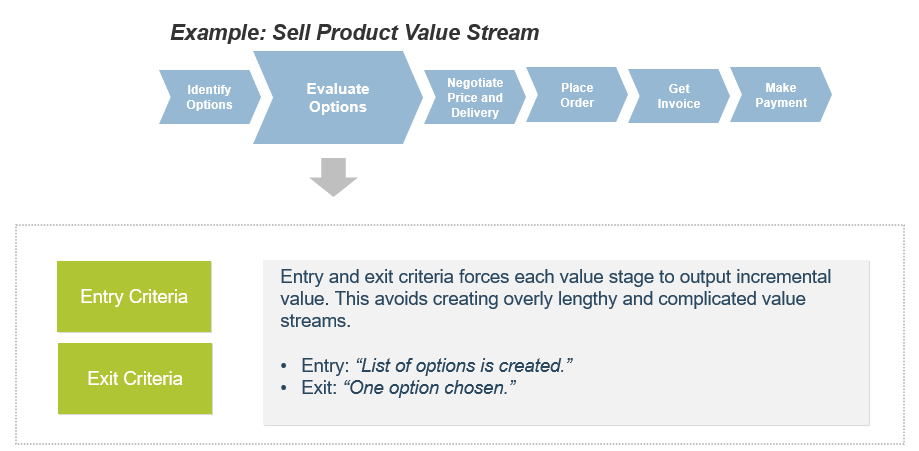
The Benefit
Establishing the entry and exit criteria for each stage will help you understand how the customer experience flows from one end of the stream to the other.
Outline the key metric(s) for each stage
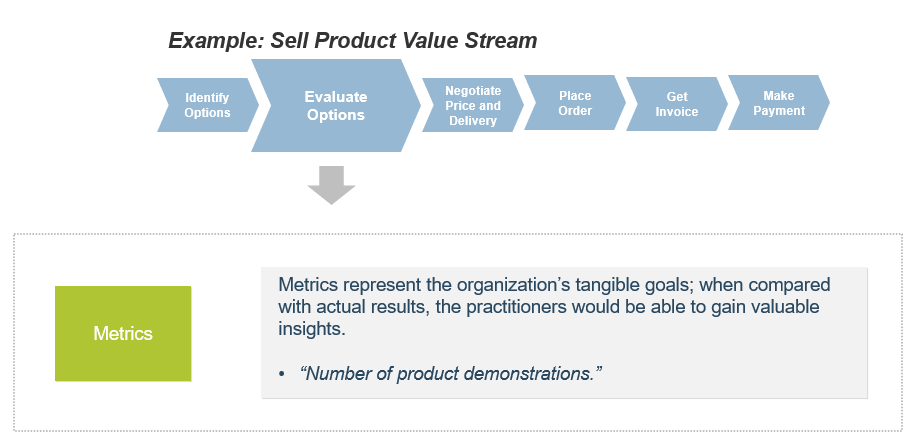
The Benefit
Setting metrics for each stage will facilitate the tracking of success and inform the business architecture practitioner of where investments should be made.
Example value stream map: Sell Product
Assess the stages of your value stream map to determine which capabilities to examine further
To determine which specific business capabilities you should seek to assess and potentially refine, you must review performance toward target metrics at each stage of the value stream.
Stages that are not performing to their targets should be examined further by assessing the capabilities that enable them.
| Value Stage | Metric Description | Metric Target | Current Measure | Meets Objective? |
| Evaluate Options | Number of Product Demonstrations | 12,000/month | 9,000/month | No |
| Identify Options | Google Searches | 100K/month | 100K/month | Yes |
| Identify Options | Product Mentions | 1M/month | 1M/month | Yes |
| … | Website Traffic (Hits) | … | … | … |
| Average Deal Size | ||||
| Number of Deals | ||||
| Time to Complete an Order | ||||
| Percentage of Invoices Without Error | ||||
| Average Time to Acquire Payment in Full |
Determine the business capabilities that support the value stage corresponding with the failing metric
Sell Product
Identify Options > Evaluate Options > Negotiate Price and Delivery Date > Place Order > Get Invoice > Make Payment
The value stage(s) that doesn’t meet its objective metrics should be examined further.
- This is done through business capability mapping and assessment.
- Starting at the highest level (level 0) view of a business, the business architecture practitioner must drill down into the lower level capabilities that support the specific value stage to diagnose/improve an issue.
Info-Tech Insight
In the absence of tangible metrics, you will have to make a qualitative judgement about which stage(s) of the value stream warrant further examination for problems and opportunities.
Build business capability map
Align supporting capabilities to priority activities.
| Business context | Define value streams | Build business capability map |
|---|---|---|
| 1.1 Select key stakeholders 1.2 Collect and understand corporate goals |
2.1 Update or define value streams 2.2 Decompose and analyze selected value stream |
3.1 Build Level 1 capability map 3.2 Build Level 2 capability map 3.3 Heatmap capability map 3.4 Roadmap |
This step will walk you through the following activities:
- Determine which business capabilities support value streams
- Accelerate the process with an industry reference architecture
- Validate the business capability map
- Establish level 2 capability
This step involves the following participants:
- Enterprise/Business Architect
- Business Analysts
- Business Unit Leads
- CIO
- Departmental Executives & Senior Managers
Outcomes of this step
Develop a business capability map – level 1
- Business architecture consists of a set of techniques to create multiple views of an organization; the primary view is known as a business capability map.
- A business capability defines what a business does to enable value creation and achieve outcomes, rather than how. Business capabilities are business terms defined using descriptive nouns such as “Marketing” or “Research and Development.” They represent stable business functions, are unique and independent of each other, and typically will have a defined business outcome. Business capabilities should not be defined as organizational units and are typically longer lasting than organizational structures.
- A business capability mapping process should begin at the highest-level view of an organization, the level 1, which presents the entire business on a page.
- An effective method of organizing business capabilities is to split them into logical groupings or categories. At the highest level, capabilities are either “core” (customer-facing functions) or “enabling” (supporting functions).
- As a best practice, Info-Tech recommends dividing business capabilities into the categories illustrated to the right.
The Business Capability Map is the primary visual representation of the organization’s key abilities or services that are delivered to stakeholders. This model forms the basis of strategic planning discussions.
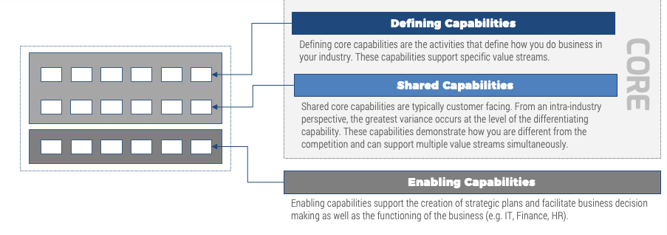
Example business capability map – Higher Education
A business capability map can be thought of as a visual representation of your organization’s business capabilities and represents a view of what your data program must support.
Validate your business capability map with the right stakeholders, including your executive team, business unit leaders, and/or other key stakeholders.
Example business capability map for: Higher Education
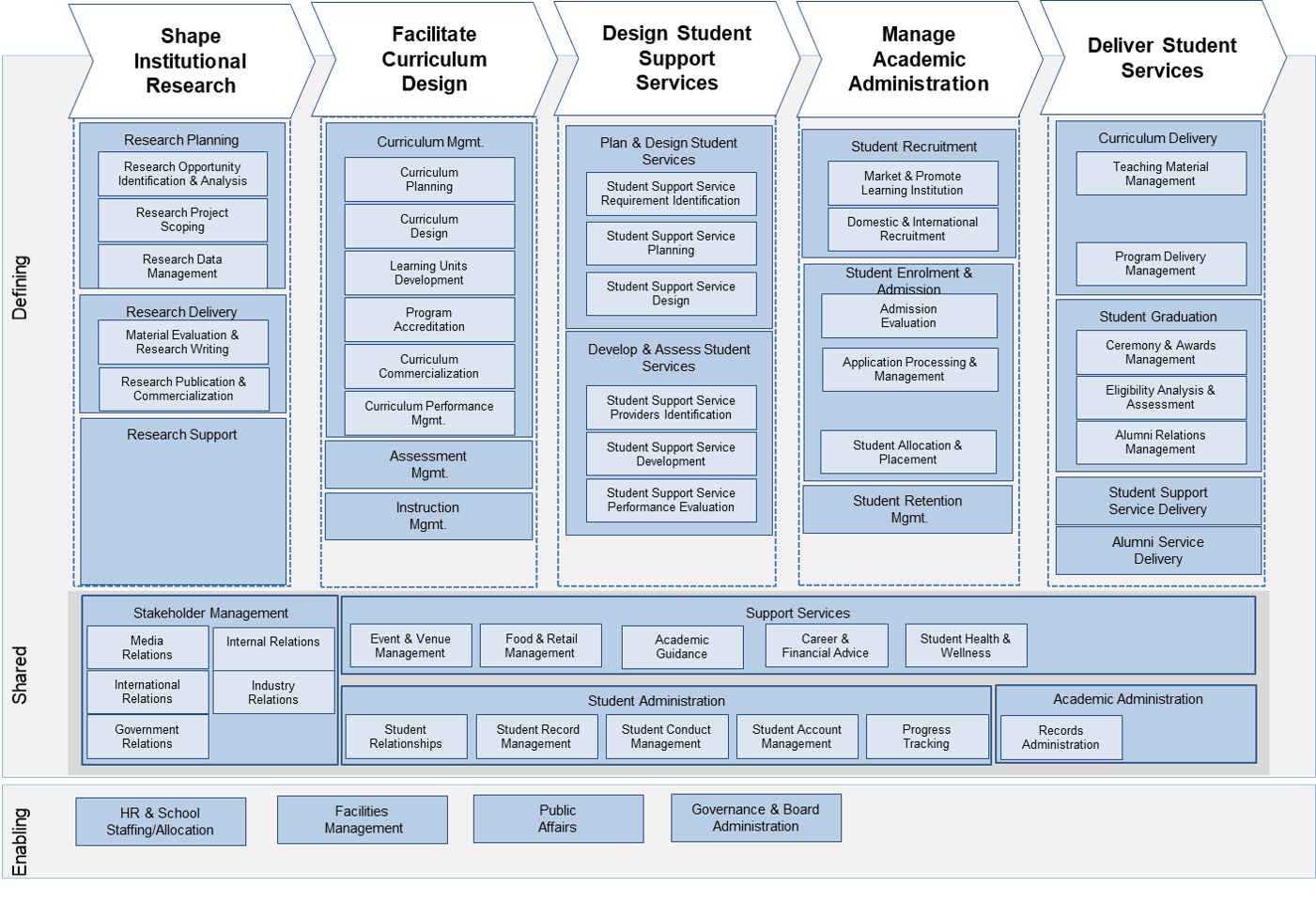
Example business capability map – Local Government
A business capability map can be thought of as a visual representation of your organization’s business capabilities and represents a view of what your data program must support.
Validate your business capability map with the right stakeholders, including your executive team, business unit leaders, and/or other key stakeholders.
Example business capability map for: Local Government
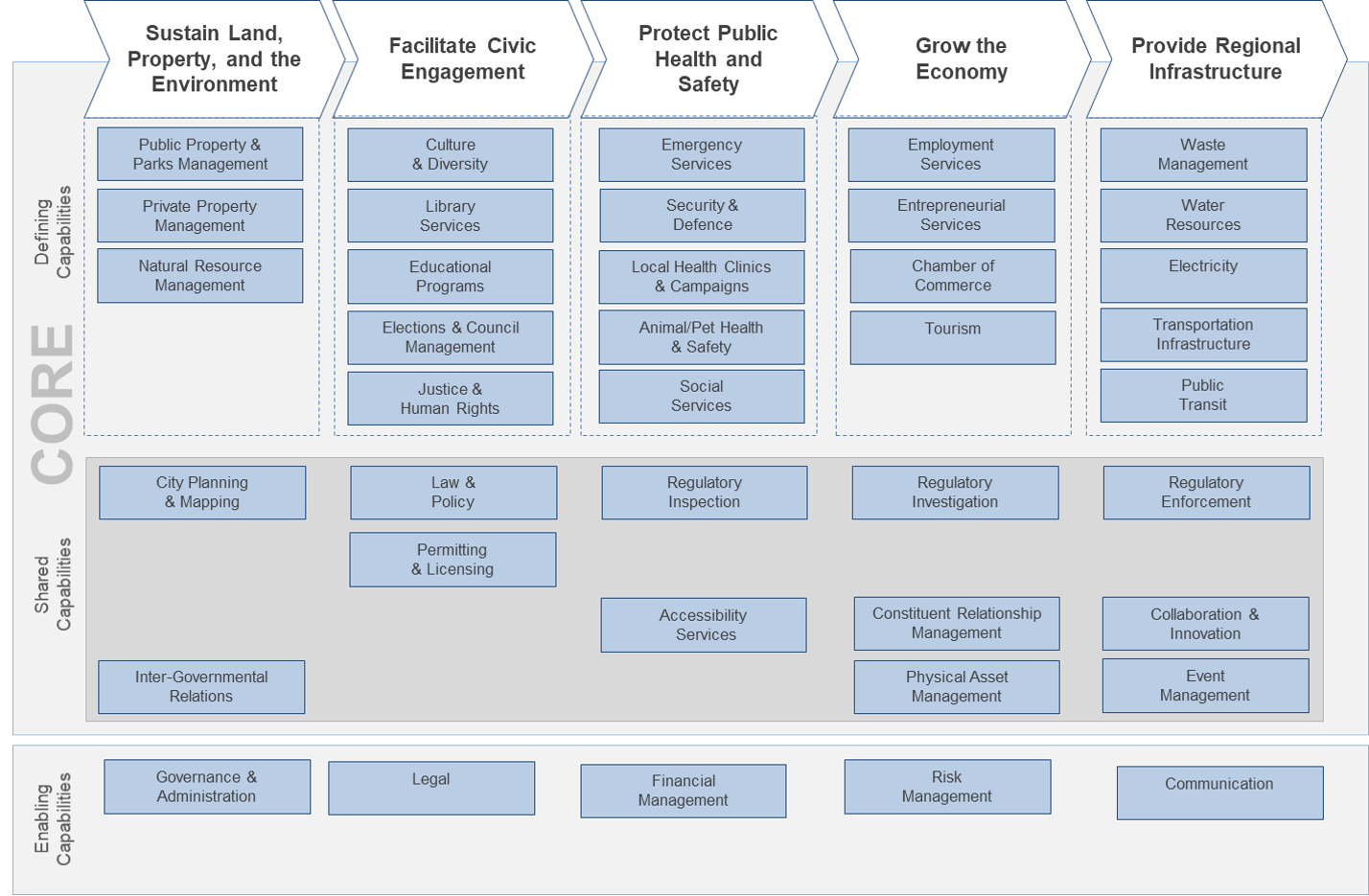
Map capabilities to value stage
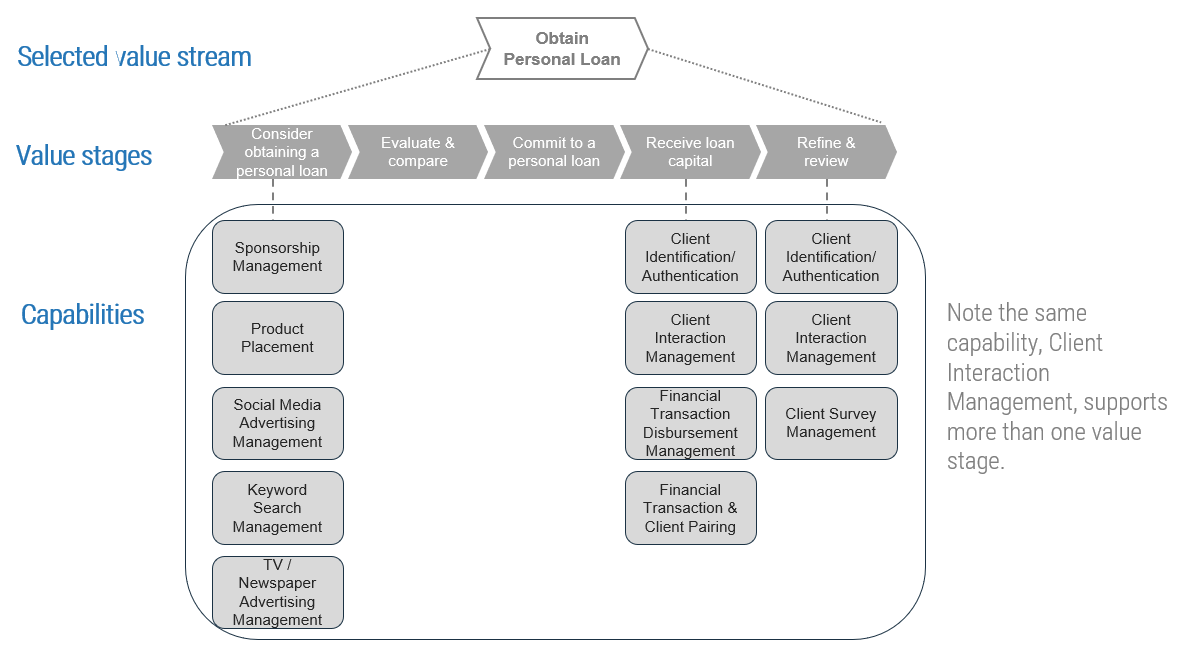
Source: Lambert, “Practical Guide to Agile Strategy Execution”
3.1 Build level 1 business capability map
1-3 hours
- Analyze the value streams to identify and describe the organization’s capabilities that support them. This stage requires a good understanding of the business and will be a critical foundation for the business capability map. Use the reference business architecture’s business capability map for your industry for examples of level 1 and 2 business capabilities and the capability map template to work in.
- Avoid:
- Don’t repeat capabilities. Capabilities are typically mutually exclusive activities.
- Don’t include temporary initiatives. Capabilities should be stable over time. The people, processes, and technologies that support capabilities will change continuously.
Ensure you engage with the right stakeholders:
Don’t waste your efforts building an inaccurate depiction of the business: The exercise of identifying capabilities for an organization is very introspective and requires deep analysis.
It is challenging to develop a common language that everyone will understand and be able to apply. Invest in the time to ensure the right stakeholders are brought into the fold and bring their business area expertise and understanding to the table.
| Input | Output |
|---|---|
|
|
| Materials | Participants |
|
|
Prioritize one value stream and build a business architecture to level 2 capabilities
Prioritize your innovation objectives and business goals, and identify a value stream to transform.
Align the innovation goals and business objectives of your organization to your value streams (the critical actions that take place within your organization to add value to a customer).
Prioritize a value stream to transform based on the number of priorities aligned to a value stream and/or the business value (e.g. revenue, EBITDA earnings, competitive differentiation, or cost efficiency).
Working alongside a business or enterprise architect, build a reference architecture for the prioritized value stream up to level 2.
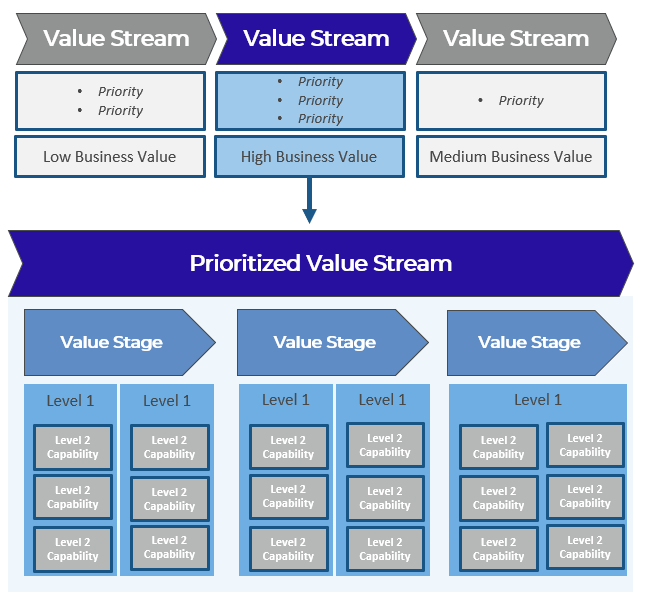
Info-Tech Insight
To produce maximum impact, focus on value streams that provide two-thirds of your enterprise value (EBITDA earnings).
From level 1 to level 2 business capabilities
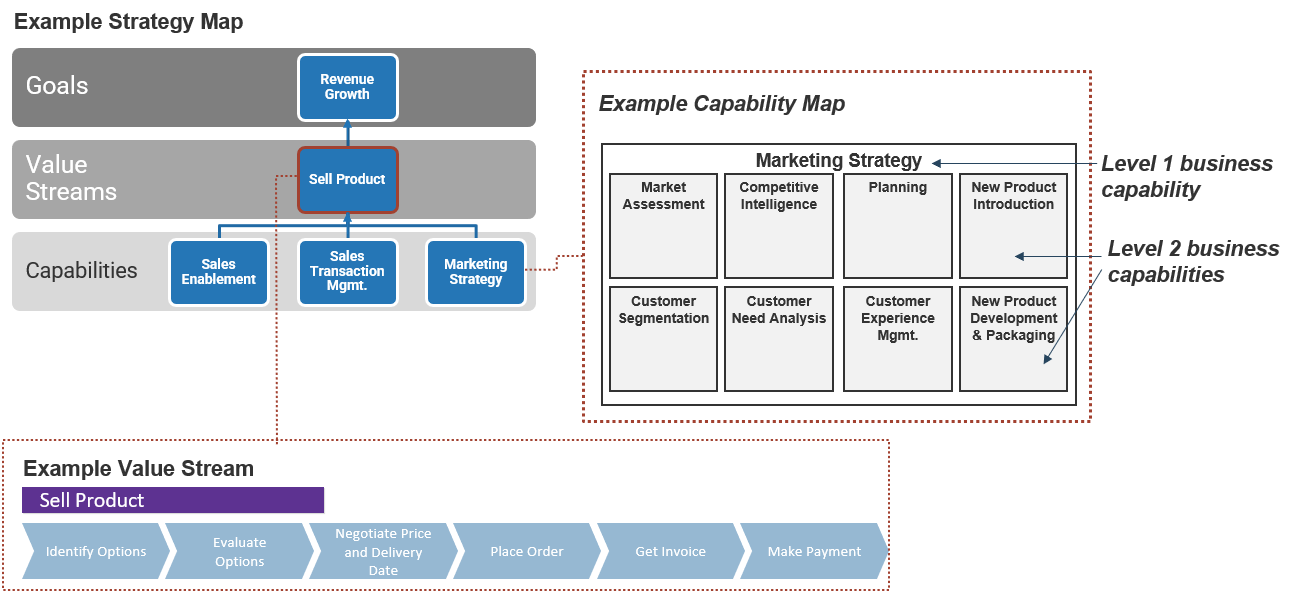
3.2 Build level 2 business capability map
1-3 hours
It is only at level 2 and further that we can pinpoint the business capabilities – the exact resources, whether applications or data or processes – that we need to focus on to realize improvements in the organization’s performance and customer experience.
- Gather industry reference models and any existing business capability maps.
- For the selected value stream, further break down its level 1 business capabilities into level 2 capabilities.
- You can often represent the business capabilities on a single page, providing a holistic visual for decision makers.
- Use meaningful names for business capabilities so that planners, stakeholders, and subject matter experts can easily search the map.
| Input | Output |
|---|---|
|
|
| Materials | Participants |
|
|
Download: See your Account Representative for access to Info-Tech’s Reference Architecture Template
3.3 Heatmap business capability map
1-3 hours
Determine the organization’s key capabilities.
- Determine cost advantage creators. If your organization has a cost advantage over competitors, the capabilities that enable it should be identified and prioritized. Highlight these capabilities and prioritize the programs that support them.
- Determine competitive advantage creators. If your organization does not have a cost advantage over competitors, determine if it can deliver differentiated end-customer experiences. Once you have identified the competitive advantages, understand which capabilities enable them. These capabilities are critical to the success of the organization and should be highly supported.
- Define key future state capabilities. In addition to the current and competitive advantage creators, the organization may have the intention to enhance new capabilities. Discuss and select the capabilities that will help drive the attainment of future goals.
- Assess how well information, applications, and processes support capabilities.
| Input | Output |
|---|---|
|
|
| Materials | Participants |
|
|
Download: See your Account Representative for access to Info-Tech’s Reference Architecture Template
Business capability map: Education
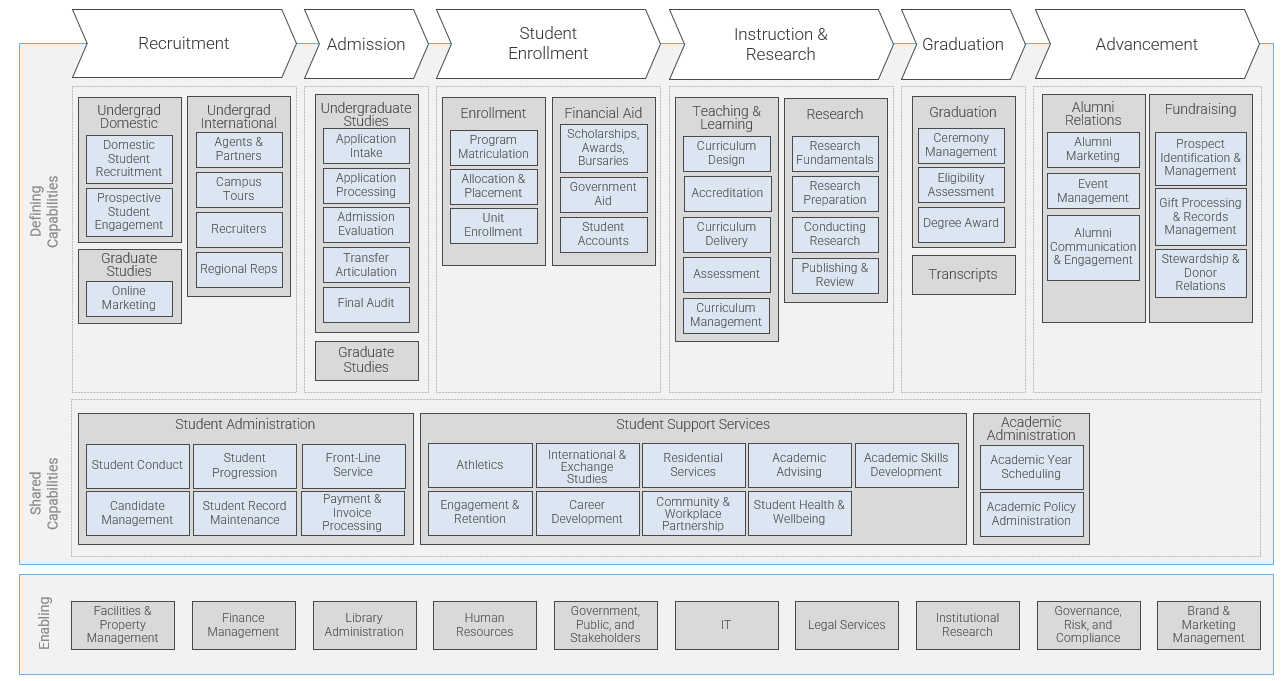
Define key capabilities
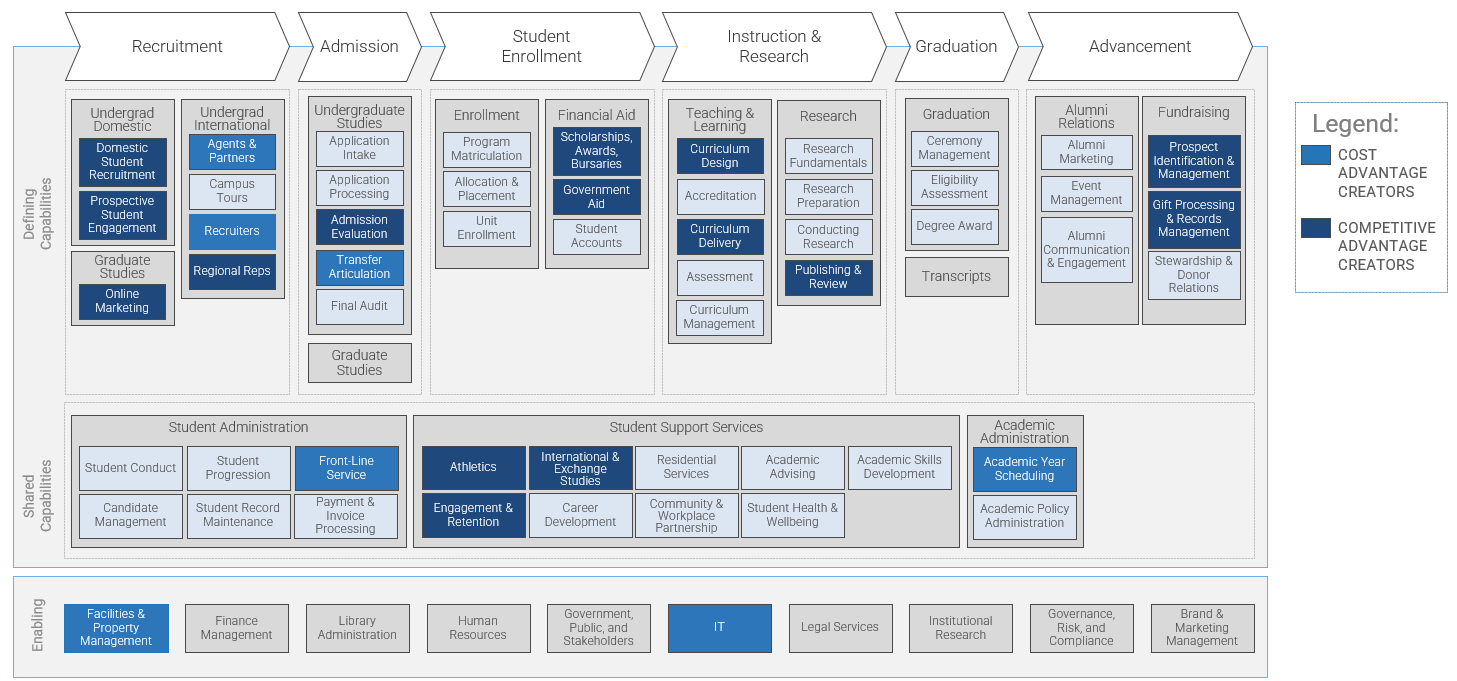
Note: Illustrative Example
Business process review
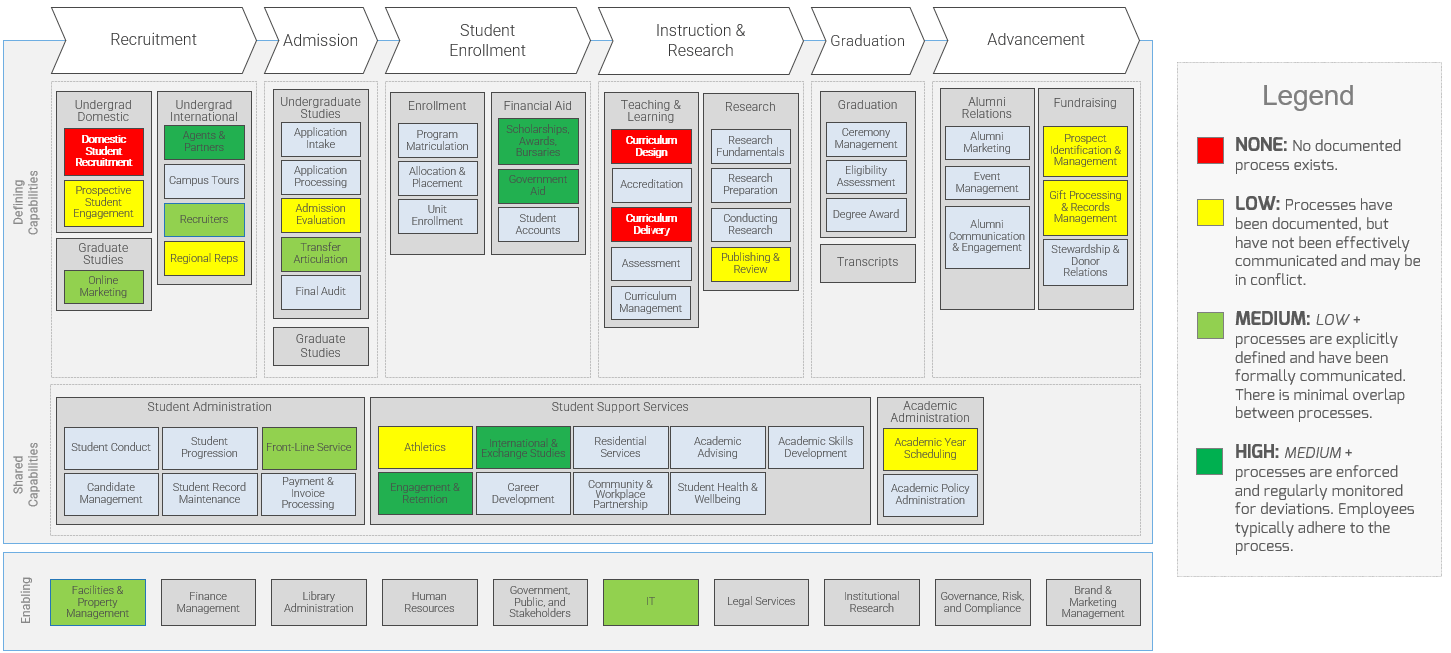
Note: Illustrative Example
Information assessment
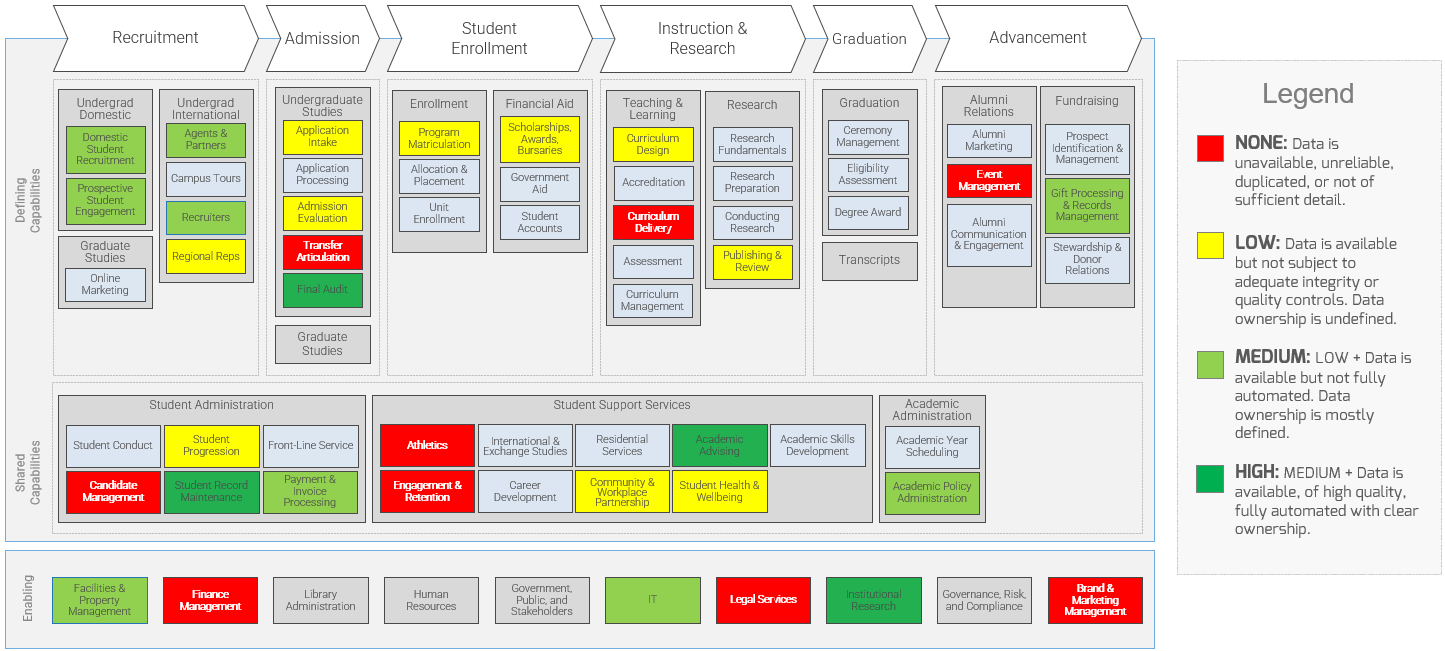
Note: Illustrative Example
Application assessment
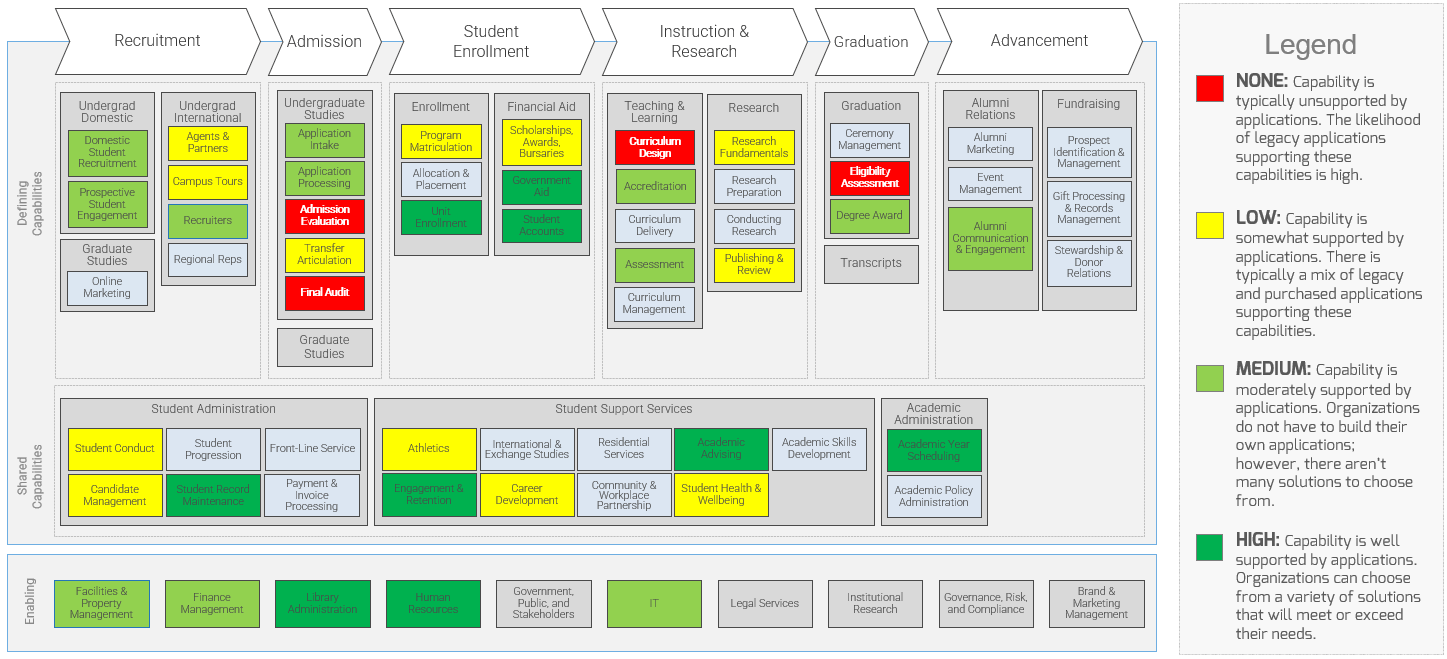
Note: Illustrative Example
MoSCoW analysis for business capabilities
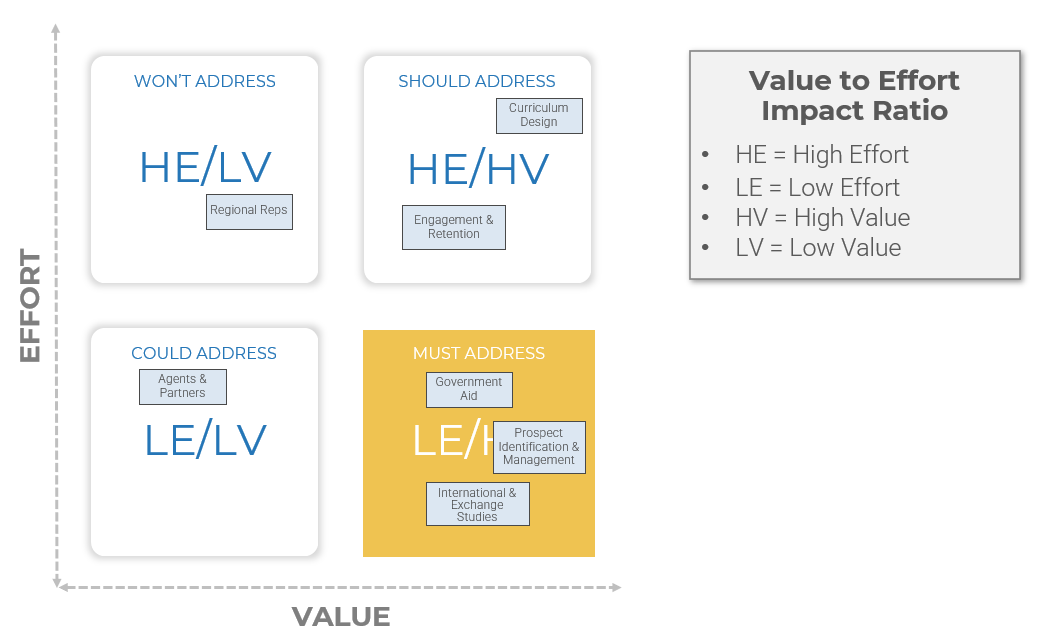
Note: Illustrative Example
Ranked list of IT implications
| MoSCoW Rank | IT Implication | Value Stream Impacted | Comments/Actions |
|---|---|---|---|
| M | [Implication] | [Value Stream] | |
| M | [Implication] | [Value Stream] | |
| M | [Implication] | [Value Stream] | |
| S | [Implication] | [Value Stream] | |
| S | [Implication] | [Value Stream] | |
| S | [Implication] | [Value Stream] | |
| C | [Implication] | [Value Stream] | |
| C | [Implication] | [Value Stream] | |
| C | [Implication] | [Value Stream] | |
| W | [Implication] | [Value Stream] | |
| W | [Implication] | [Value Stream] | |
| W | [Implication] | [Value Stream] |
3.4 Roadmap business architecture initiatives
1-3 hours
Unify the organization’s perspective on how it creates value.
- Write a short description of the value stream that includes a statement about the value provided and a clear start and end for the value stream. Validate the accuracy of the descriptions with your key stakeholders.
- Consider:
- How does the organization deliver those benefits?
- How does the customer receive the benefits?
- What is the scope of your value stream? What will trigger the stream to start and what will the final value be?
- Don’t start with a blank page. Use Info-Tech’s business architecture models for sample value streams.
| Input | Output |
|---|---|
|
|
| Materials | Participants |
|
|
Download: See your Account Representative for access to Info-Tech’s Reference Architecture Template
Example: Business architecture deliverables
| Enterprise Architecture Domain | Architectural View | Selection |
|---|---|---|
| Business Architecture | Business strategy map | Required |
| Business Architecture | Business model canvas | Optional |
| Business Architecture | Value streams | Required |
| Business Architecture | Business capability map | Not Used |
| Business Architecture | Business process flows | |
| Business Architecture | Service portfolio | |
| Data Architecture | Conceptual data model | |
| Data Architecture | Logical data model | |
| Data Architecture | Physical data model | |
| Data Architecture | Data flow diagram | |
| Data Architecture | Data lineage diagram |
Tools and templates to compile and communicate your business architecture work
The Industry Business Reference Architecture Template for your industry is a place for you to collect all of the activity outputs and outcomes you’ve completed for use in next-steps.
Download the Industry Business Reference Architecture Template for your industry
Info-Tech offers various levels of support to best suit your needs
| DIY Toolkit | Guided Implementation | Workshop | Consulting |
|---|---|---|---|
| "Our team has already made this critical project a priority, and we have the time and capability, but some guidance along the way would be helpful." | "Our team knows that we need to fix a process, but we need assistance to determine where to focus. Some check-ins along the way would help keep us on track." | "We need to hit the ground running and get this project kicked off immediately. Our team has the ability to take this over once we get a framework and strategy in place." | "Our team does not have the time or the knowledge to take this project on. We need assistance through the entirety of this project." |
Diagnostics and consistent frameworks are used throughout all four options
Research Contributors and Experts
| Name | Role | Organization |
| Ibrahim Abdel-Kader | Research Analyst, Data & Analytics | Info-Tech Research Group |
| Ben Abrishami-Shirazi | Technical Counselor, Enterprise Architecture | Info-Tech Research Group |
| Andrew Bailey | Consulting, Manager | Info-Tech Research Group |
| Dana Dahar | Research & Advisory Director, CIO / Digital Business Strategy | Info-Tech Research Group |
| Larry Fretz | VP | Info-Tech Research Group |
| Shibly Hamidur | Enterprise Architect | Toronto Transit Commission (TTC) |
| Rahul Jaiswal | Principal Research Director, Industry | Info-Tech Research Group |
| John Kemp | Executive Counselor, Executive Services | Info-Tech Research Group |
| Gerald Khoury | Senior Executive Advisor | Info-Tech Research Group |
| Igor Ikonnikov | Principal Advisory Director, Data & Analytics | Info-Tech Research Group |
| Daniel Lambert | VP | Benchmark Consulting |
| Milena Litoiu | Principal Research Director, Enterprise Architecture | Info-Tech Research Group |
| Andy Neill | AVP Data & Analytics, Chief Enterprise Architect | Info-Tech Research Group |
| Rajesh Parab | Research Director, Data & Analytics | Info-Tech Research Group |
| Rick Pittman | VP, Research | Info-Tech Research Group |
| Irina Sedenko | Research Director, Data & Analytics | Info-Tech Research Group |
Bibliography
Andriole, Steve. “Why No One Understands Enterprise Architecture & Why Technology Abstractions Always Fail.” Forbes, 18 September 2020. Web.
“APQC Process Classification Framework (PCF) – Retail.” American Productivity & Quality Center, 9 January 2019. Web.
Brose, Cari. “Who’s on First? Architecture Roles and Responsibilities in SAFe.” Business Architecture Guild, 9 March 2017. Web.
Burlton, Roger, Jim Ryne, and Daniel St. George. “Value Streams and Business Processes: The Business Architecture Perspective.” Business Architecture Guild, December 2019. Web.
“Business Architecture: An overview of the business architecture professional.” Capstera, 5 January 2022. Web.
Business Architecture Guild. “What is Business Architecture?” Business Analyst Mentor, 18 November 2022. Web.
“Business Architecture Overview.” The Business Architecture Working Group of the Object Management Group (OMG), n.d. Web.
“Delivering on your strategic vision.” The Business Architecture Guild, n.d. Web.
Ecker, Grant. “Deploying business architecture.” LinkedIn, 11 November 2021. (Presentation)
IRIS. “Retail Business Architecture Framework and Examples.” IRIS Business Architect, n.d. Web.
IRIS. “What Is Business Architecture?” IRIS Business Architect, 8 May 2014. Web.
IRIS. “Your Enterprise Architecture Practice Maturity 2021 Assessment.” IRIS Business Architect, 17 May 2021. Web.
Khuen, Whynde. “How Business Architecture Breaks Down and Bridges Silos.” Biz Arch Mastery, January 2020. Web.
Lambert, Daniel. “Practical Guide to Agile Strategy Execution.” 18 February 2020.
Lankhorst, Marc, and Bernd Ihnen. “Mapping the BIZBOK Metamodel to the ArchiMate Language.” Bizzdesign, 2 September 2021. Web.
Ramias, Alan, and Andrew Spanyi, “Demystifying the Relationship Between Processes and Capabilities: A Modest Proposal.” BPTrends, 2 February 2015. Web.
Newman, Daniel. “NRF 2022: 4 Key Trends From This Year’s Big Show.” Forbes, 20 January 2022. Web.
Research and Markets. “Define the Business Context Needed to Complete Strategic IT Initiatives: 2018 Blueprint.” Business Wire, 1 February 2018. Web.
Sabanoglu, Tugba. “Retail market worldwide - Statistics & Facts.” Statista, 21 April 2022. Web.
Spacey, John. “Capability vs Process.” Simplicable, 18 November 2016. Web.
“The Definitive Guide to Business Capabilities.” LeanIX, n.d. Web.
TOGAF 9. Version 9.1. The Open Group, 2011. Web.
“What is Business Architecture?” STA Group, 2017. PDF.
Whittie, Ralph. “The Business Architecture, Value Streams and Value Chains.” BA Institute, n.d. Web.
Buying Options
Map Your Business Architecture to Define Your Strategy
Client rating
Cost Savings
Days Saved
IT Risk Management · IT Leadership & Strategy implementation · Operational Management · Service Delivery · Organizational Management · Process Improvements · ITIL, CORM, Agile · Cost Control · Business Process Analysis · Technology Development · Project Implementation · International Coordination · In & Outsourcing · Customer Care · Multilingual: Dutch, English, French, German, Japanese · Entrepreneur
Tymans Group is a brand by Gert Taeymans BV
Gert Taeymans bv
Europe: Koning Albertstraat 136, 2070 Burcht, Belgium — VAT No: BE0685.974.694 — phone: +32 (0) 468.142.754
USA: 4023 KENNETT PIKE, SUITE 751, GREENVILLE, DE 19807 — Phone: 1-917-473-8669
Copyright 2017-2022 Gert Taeymans BV